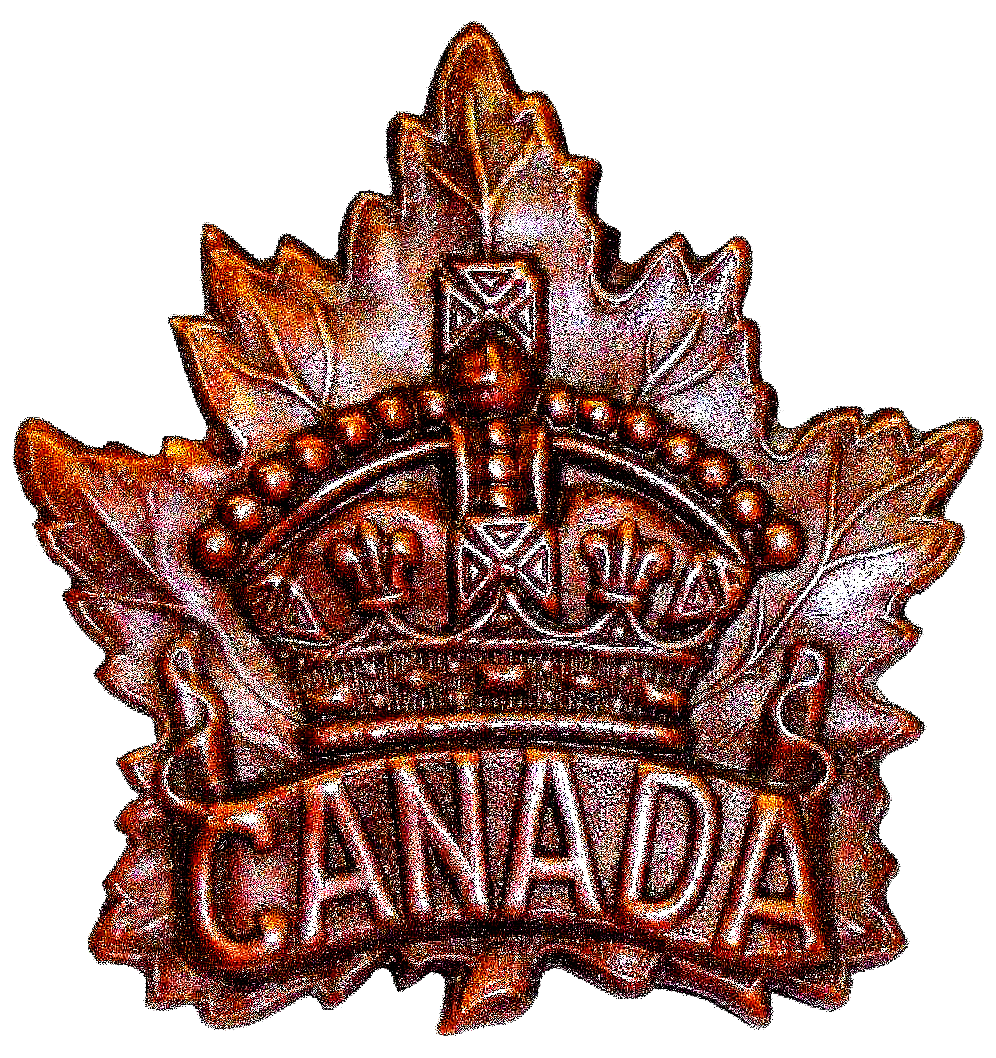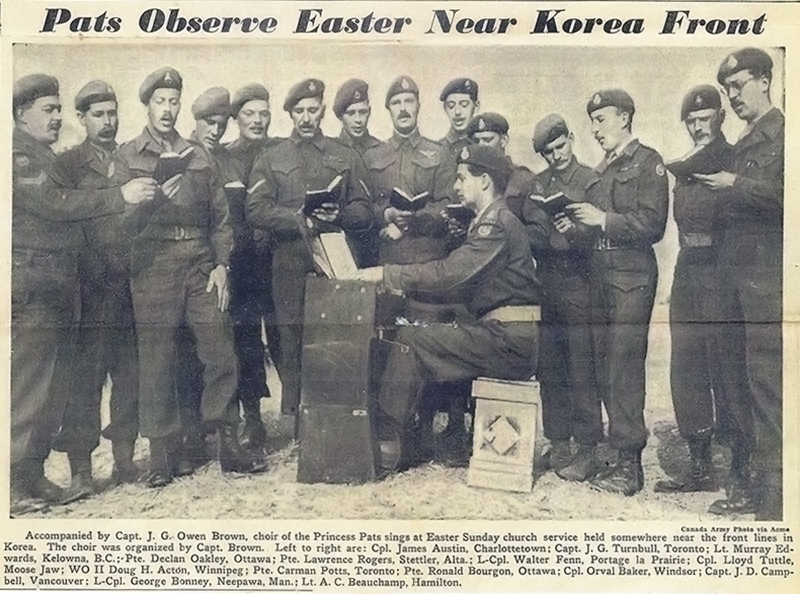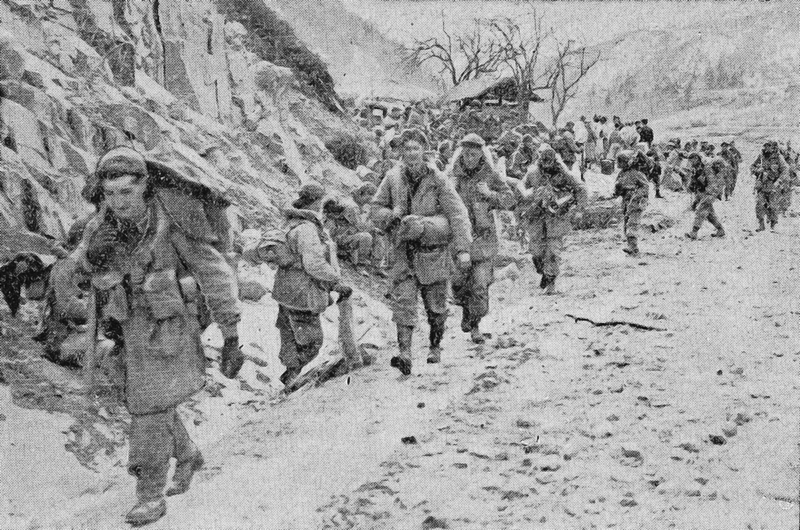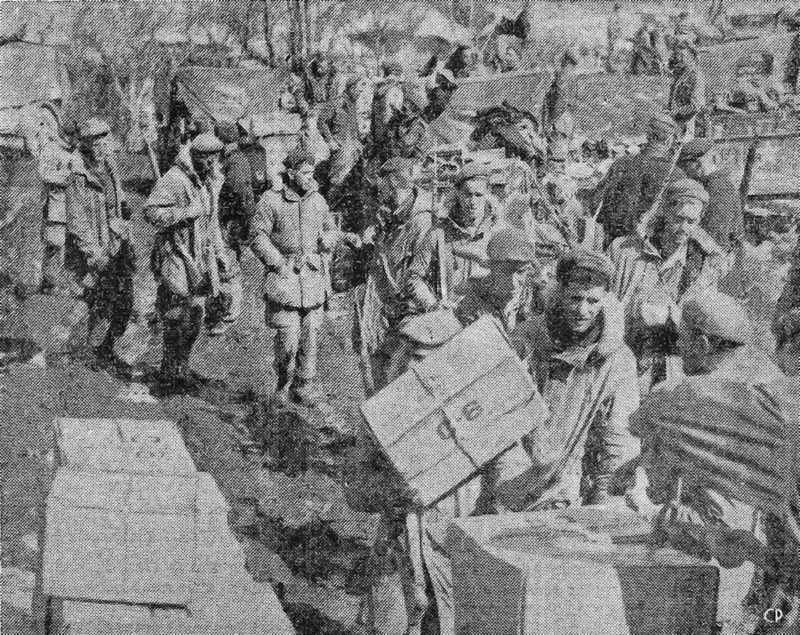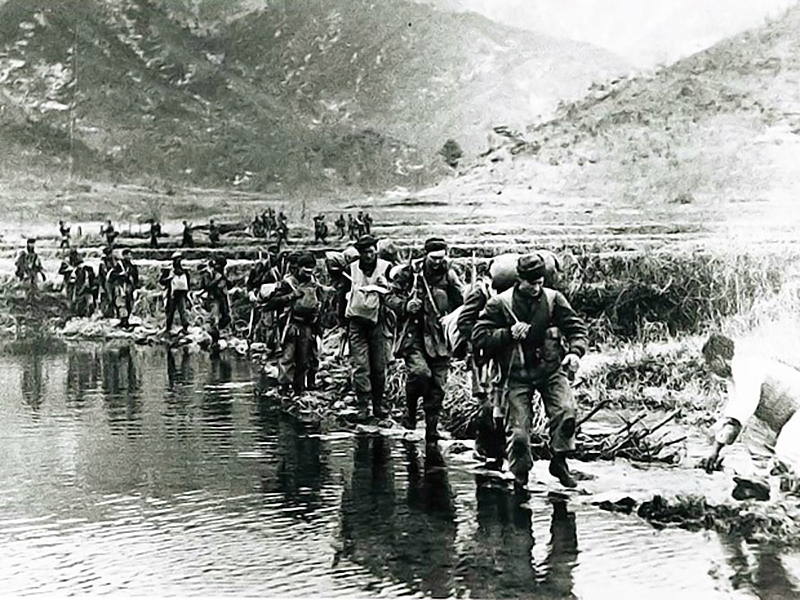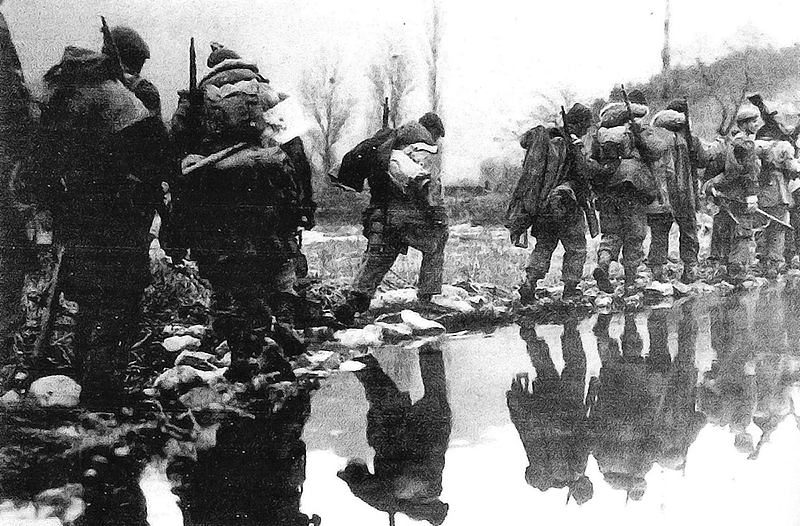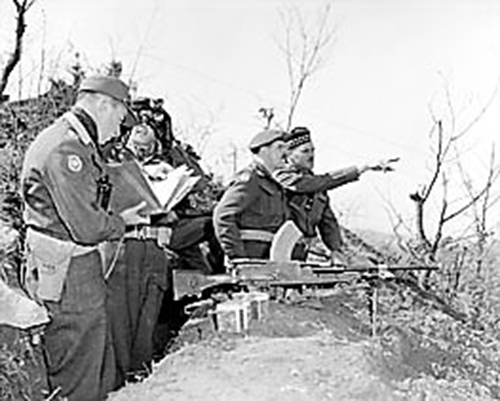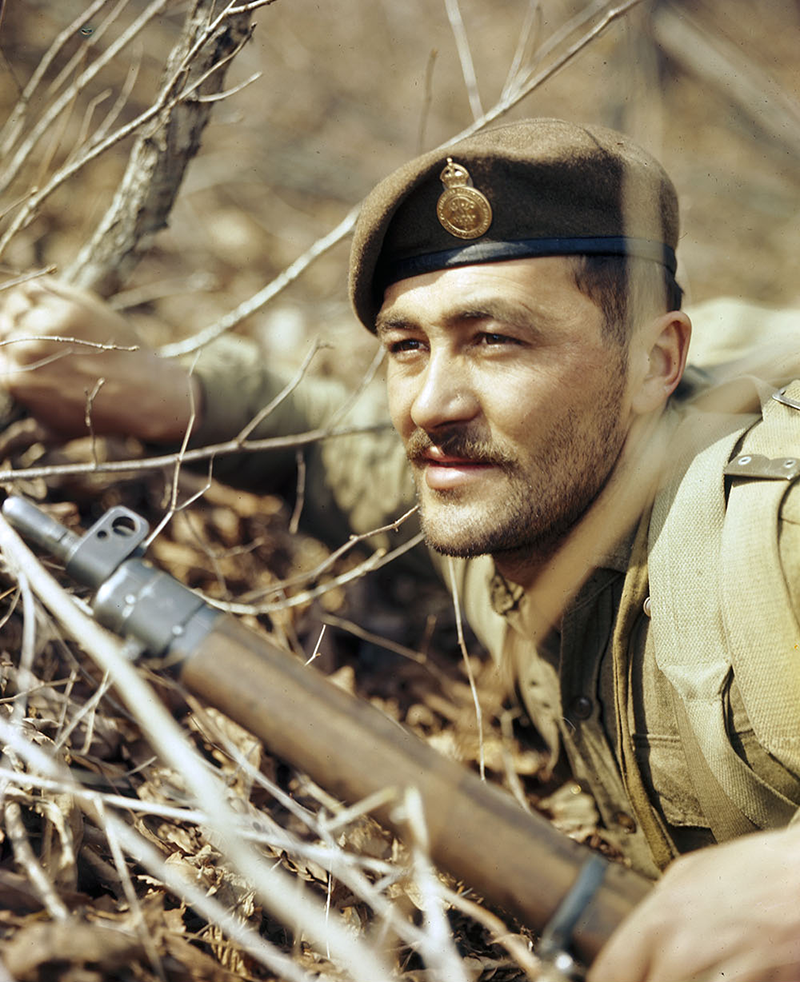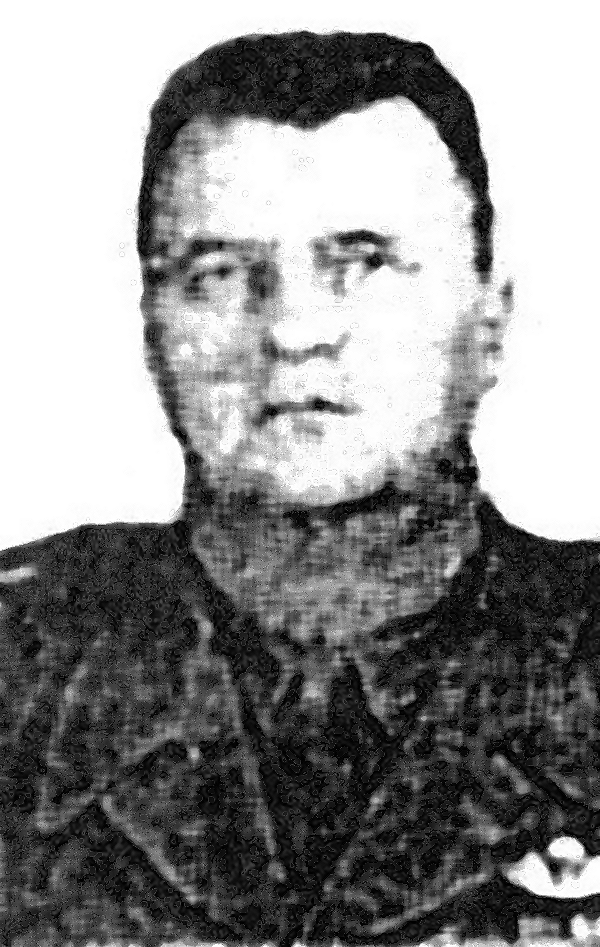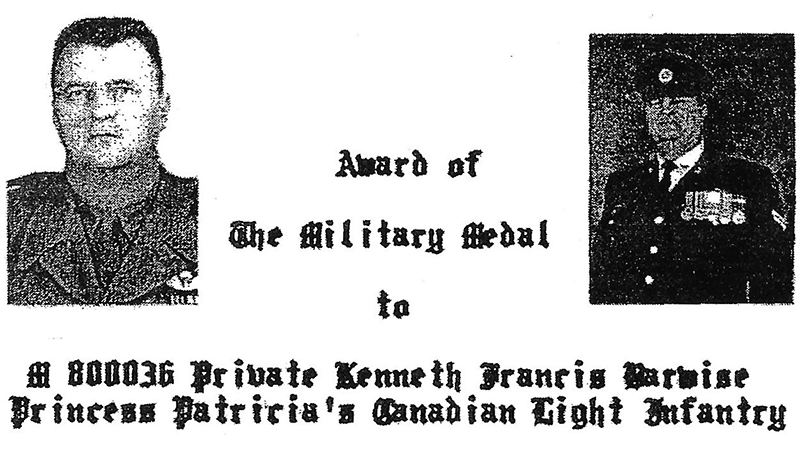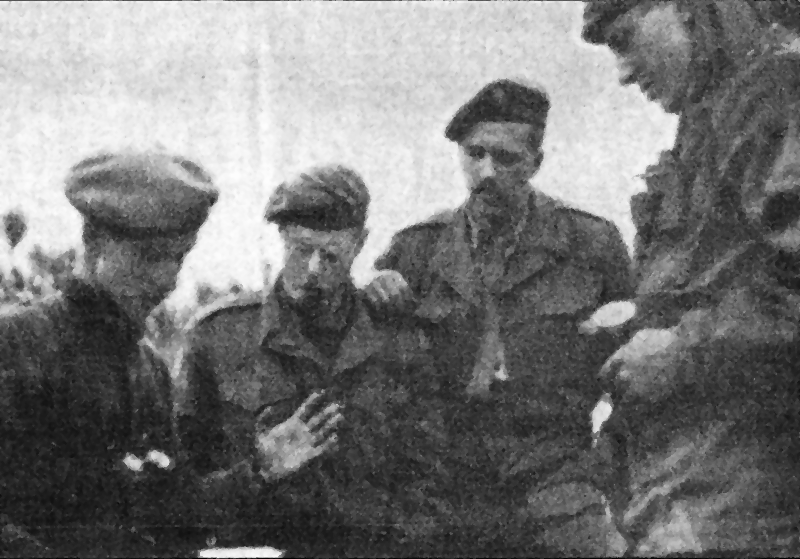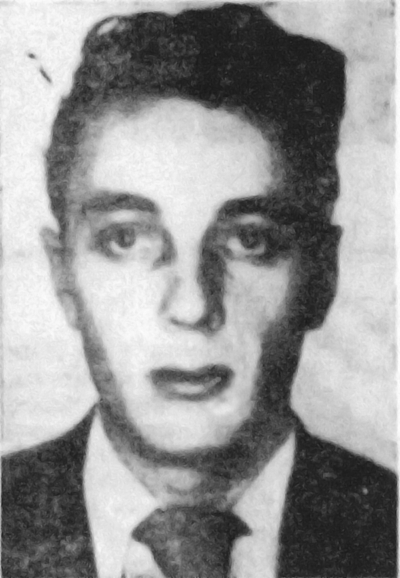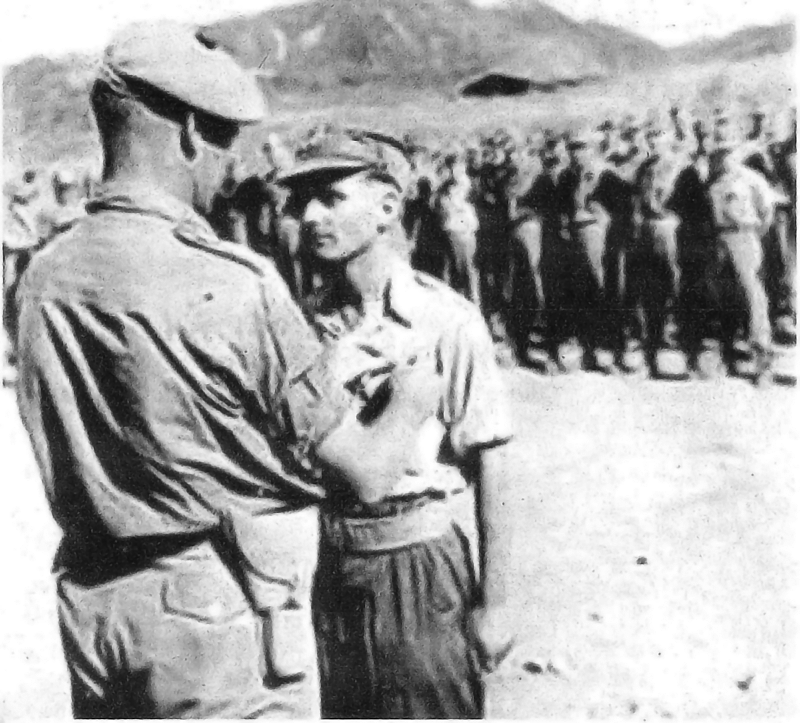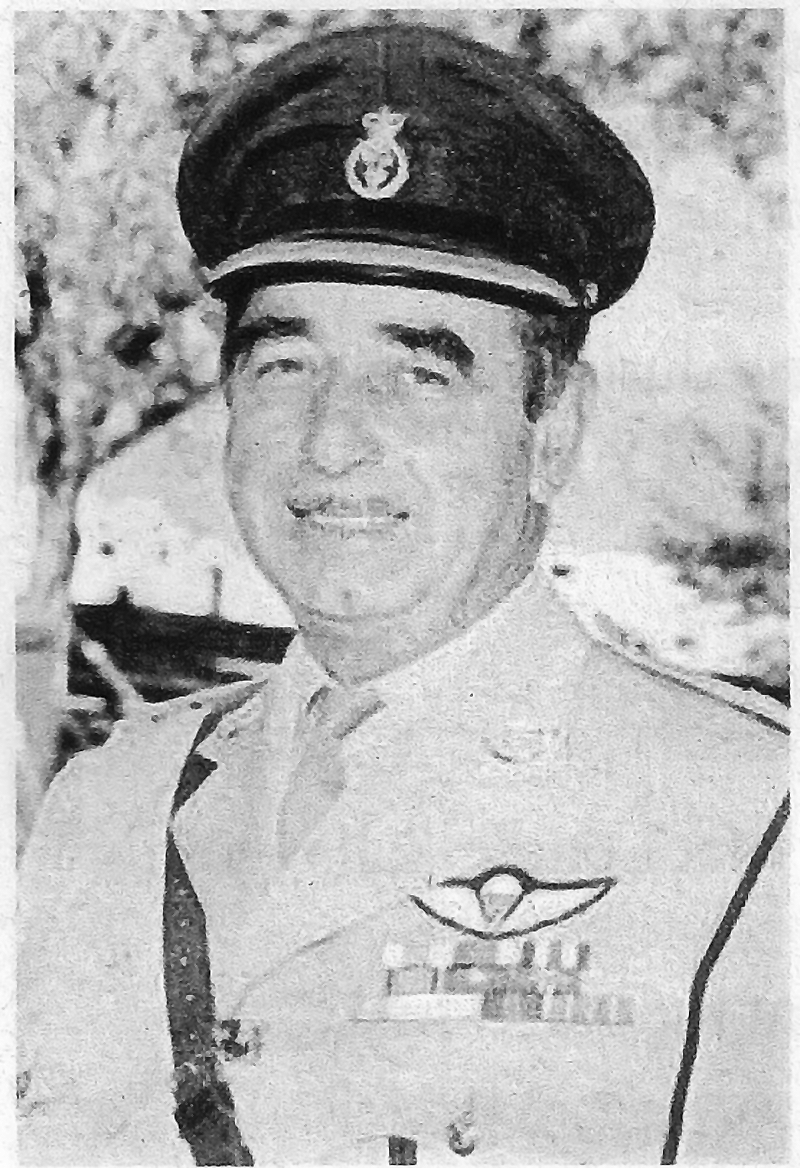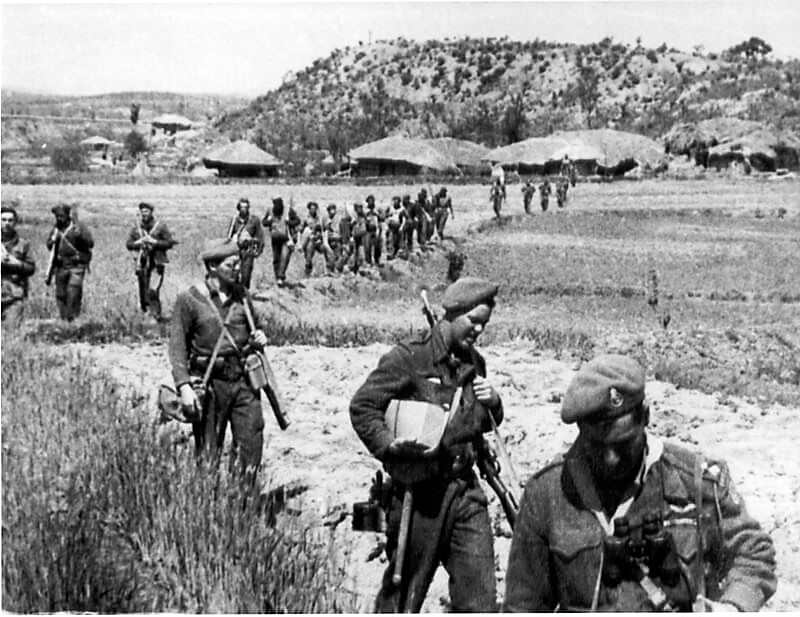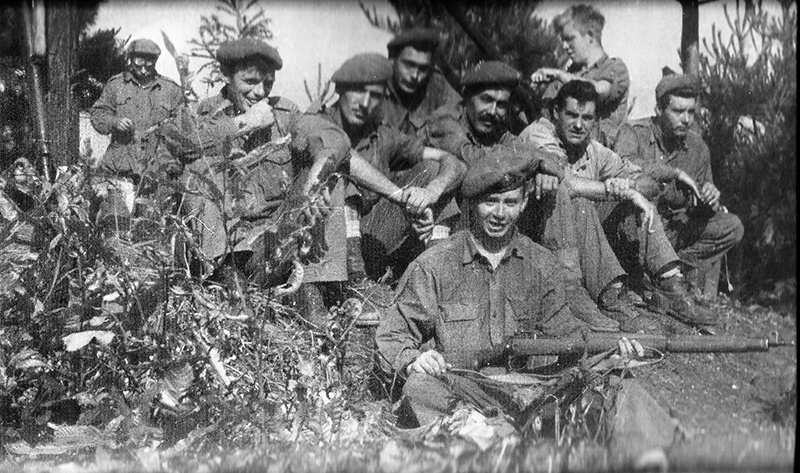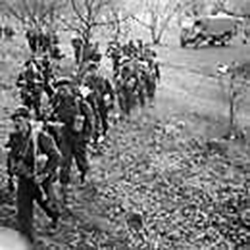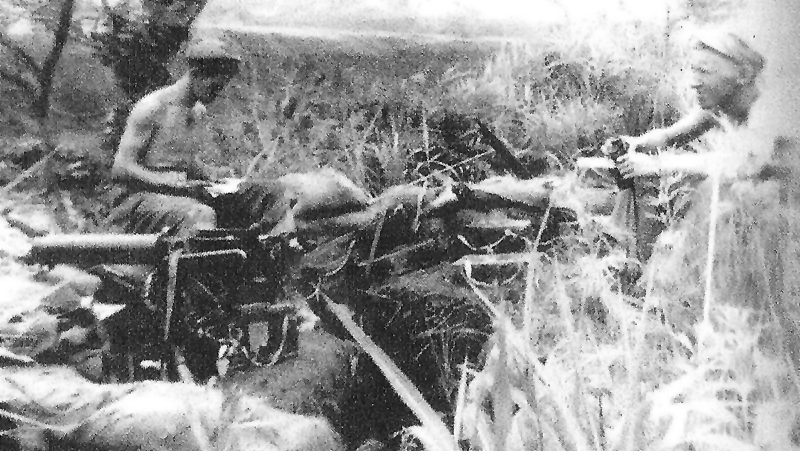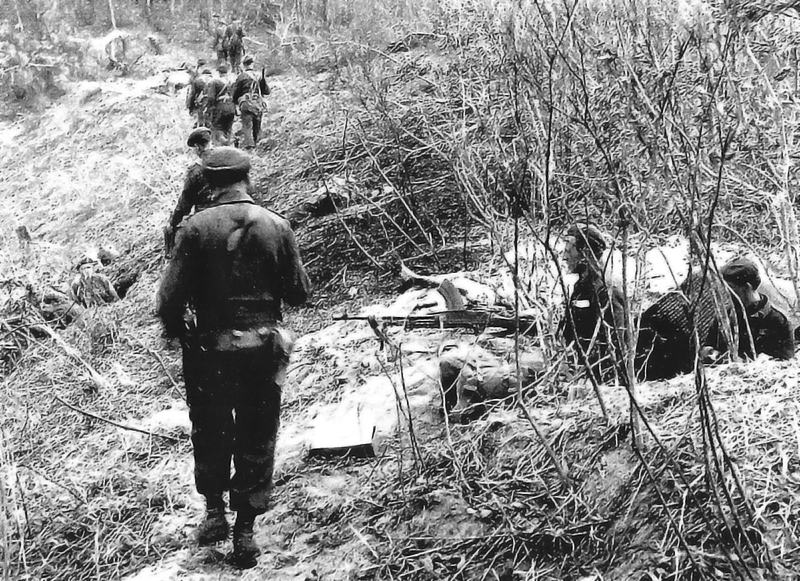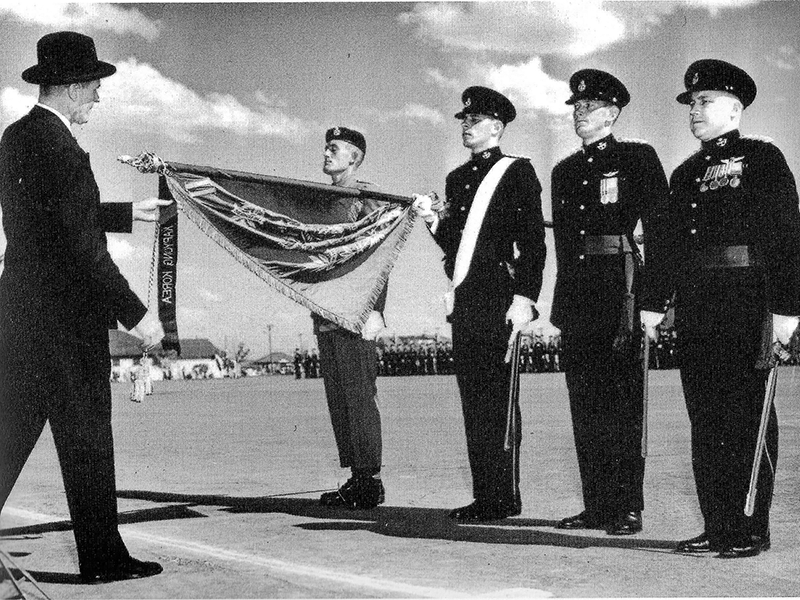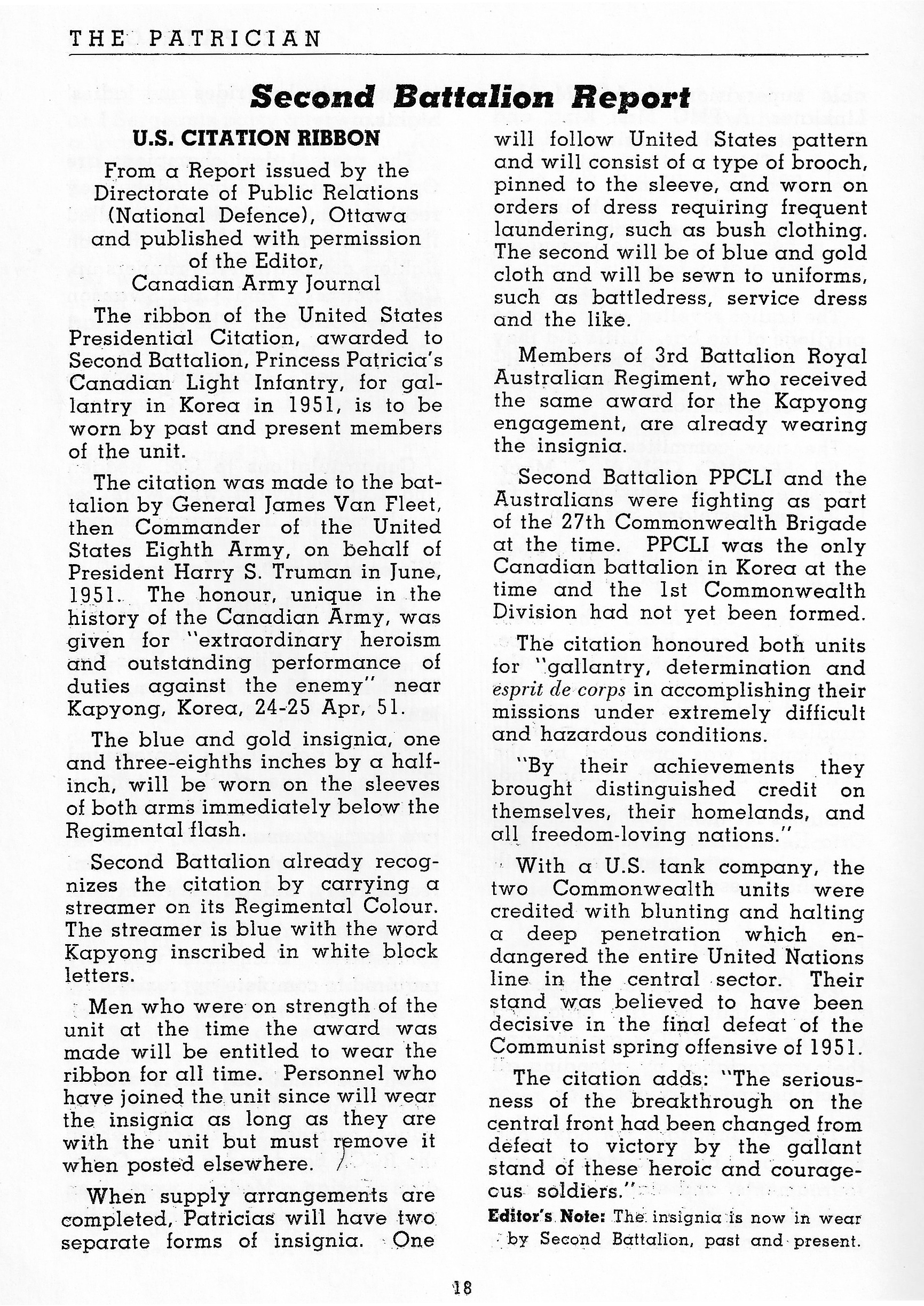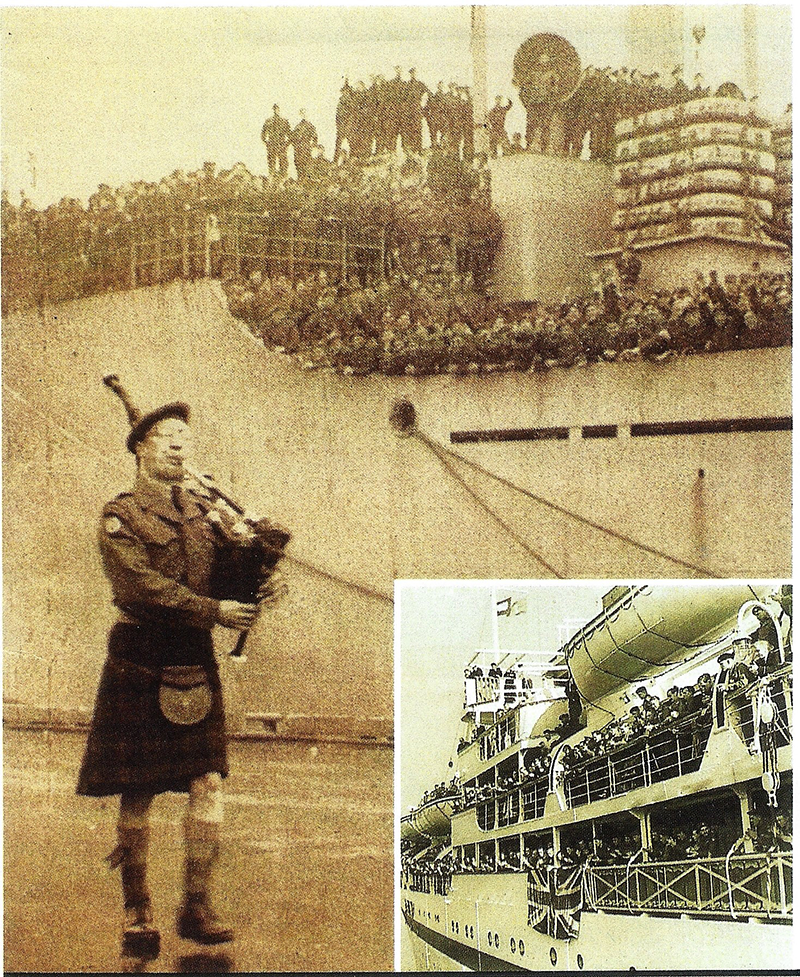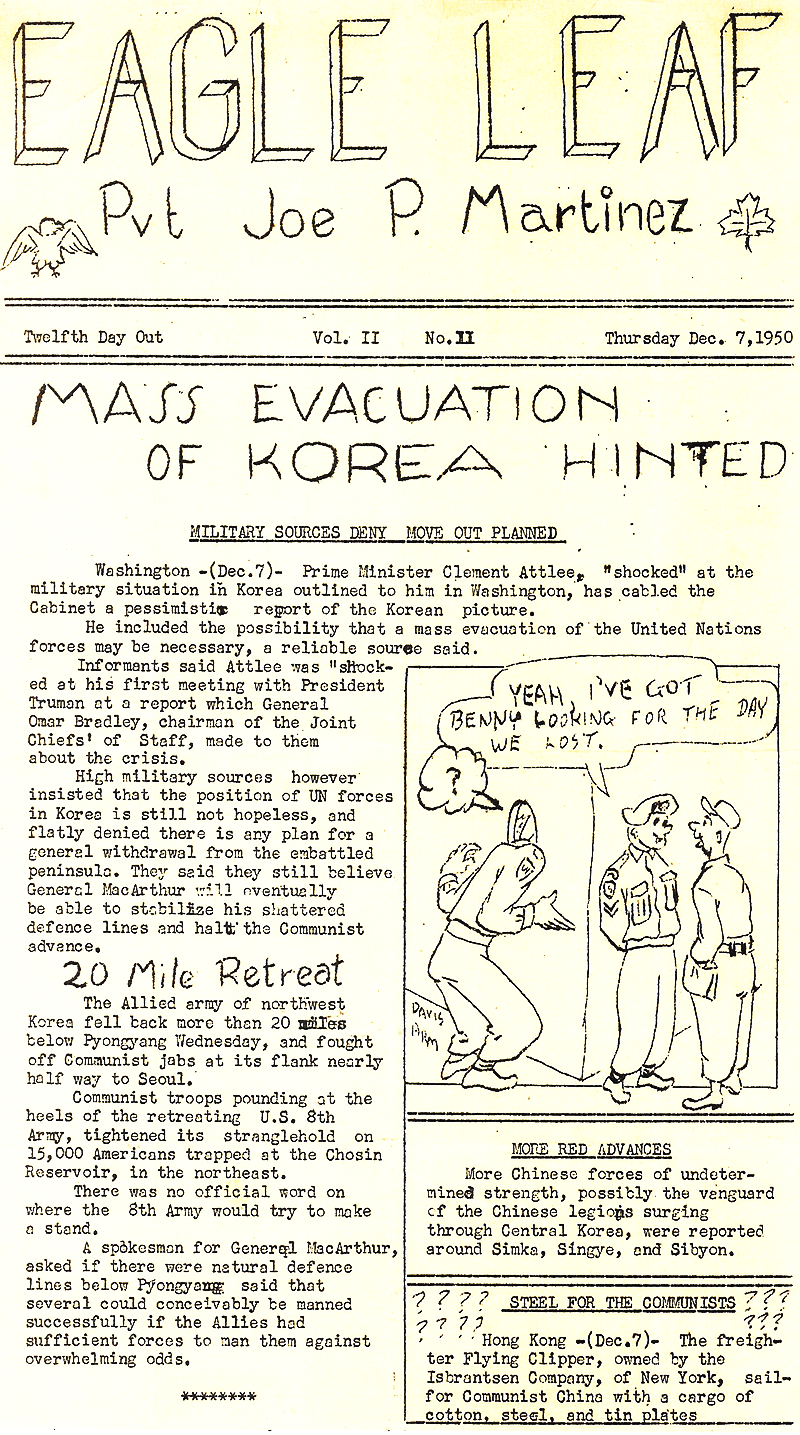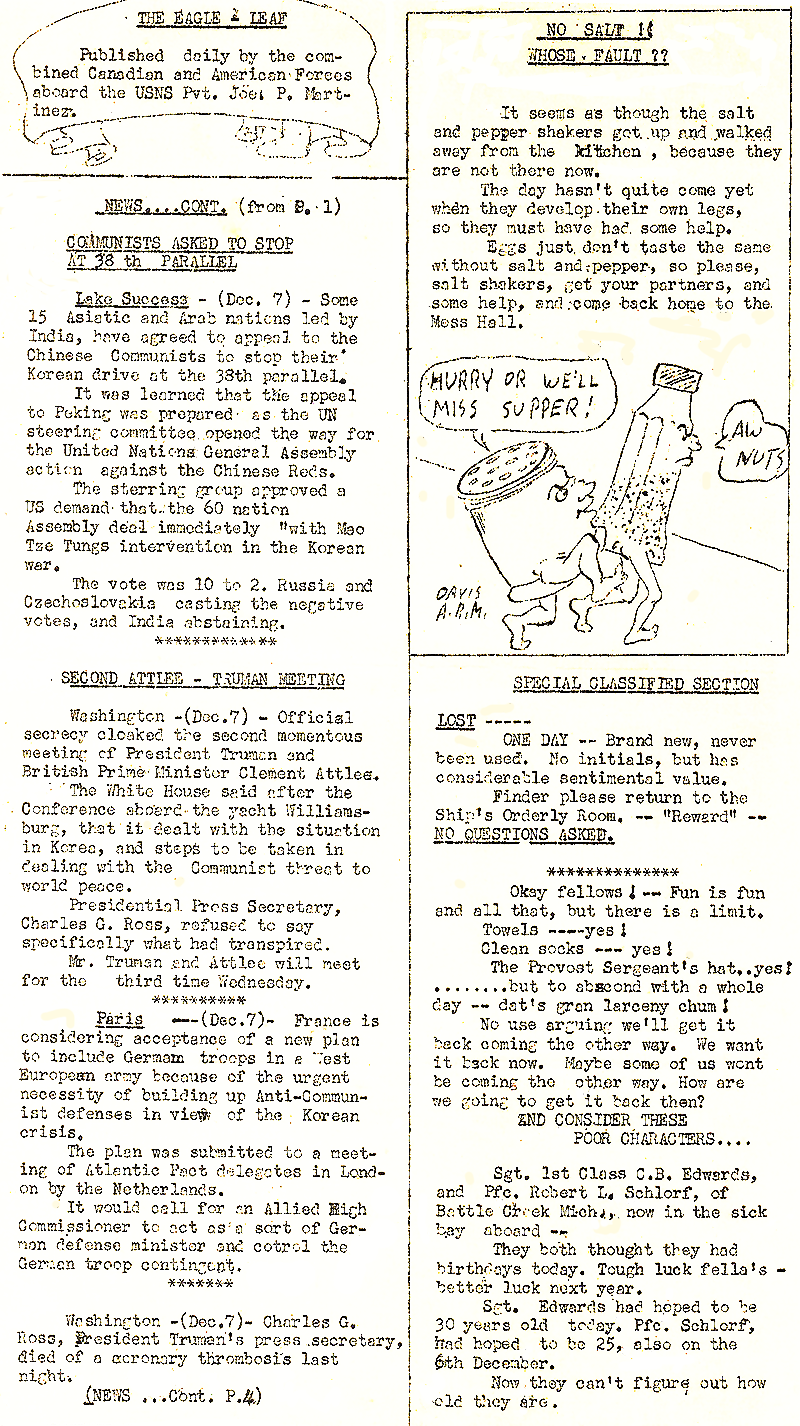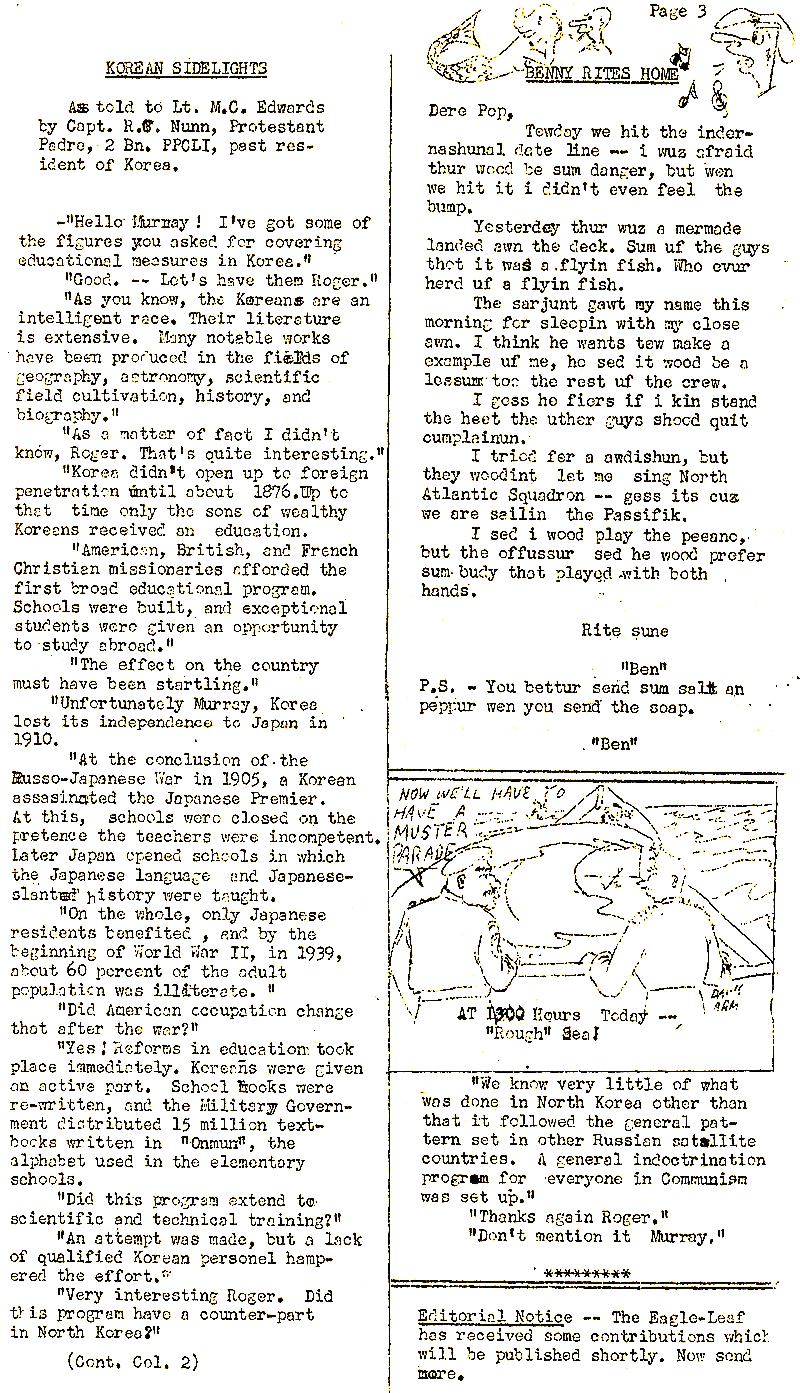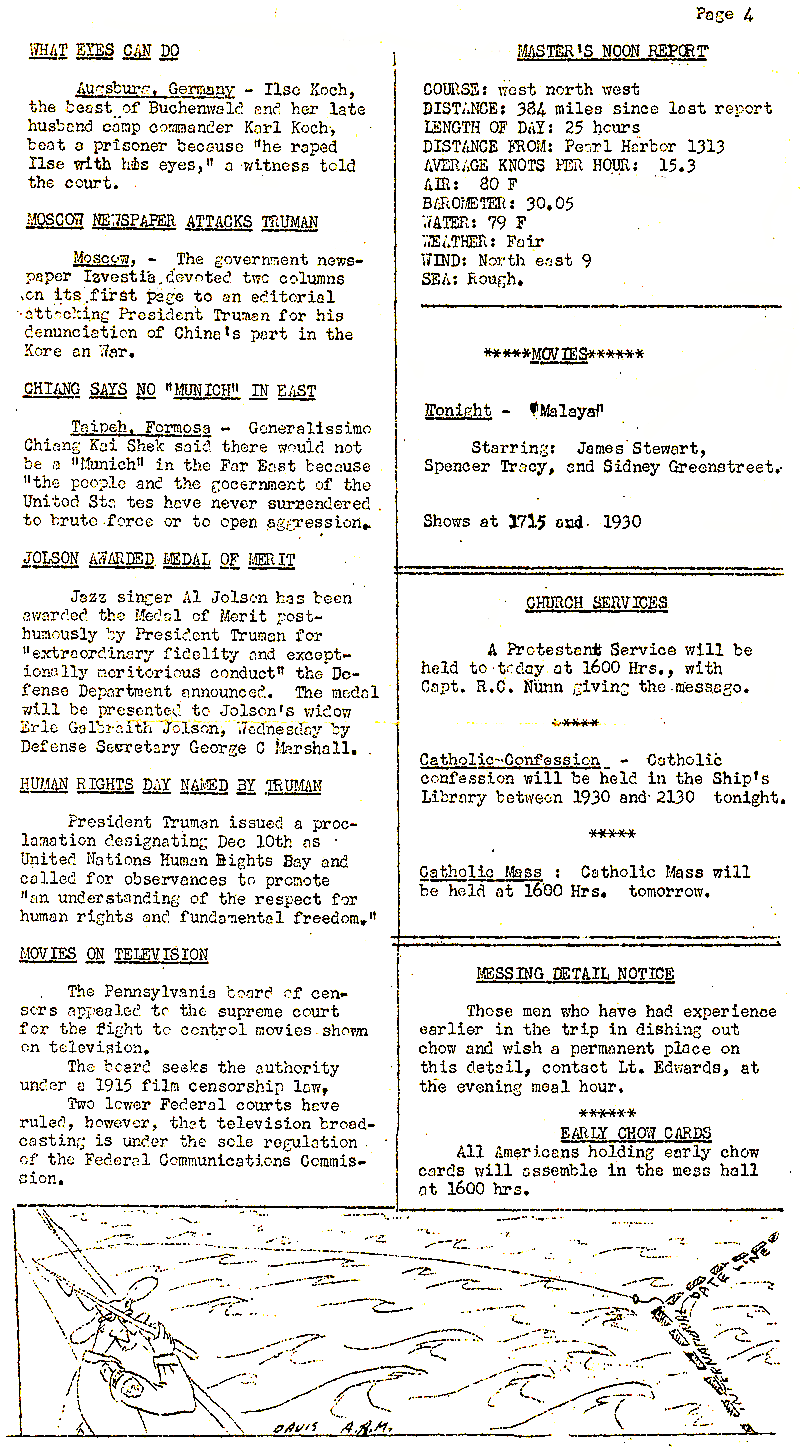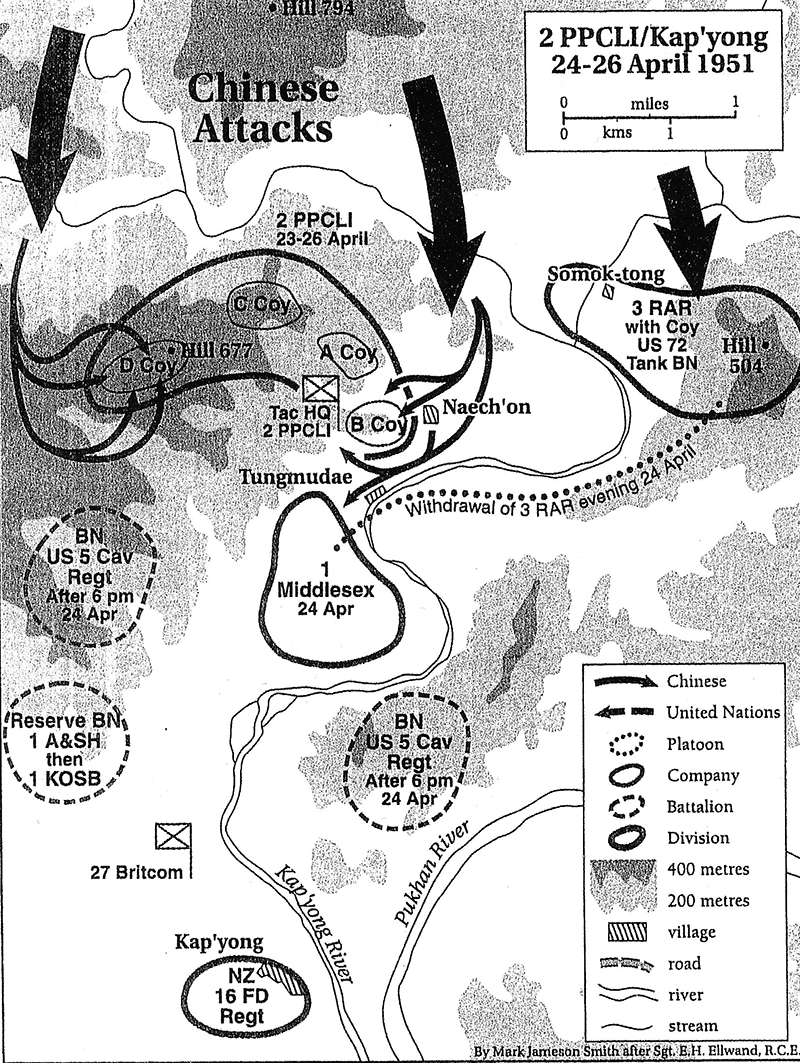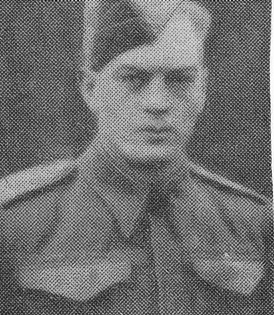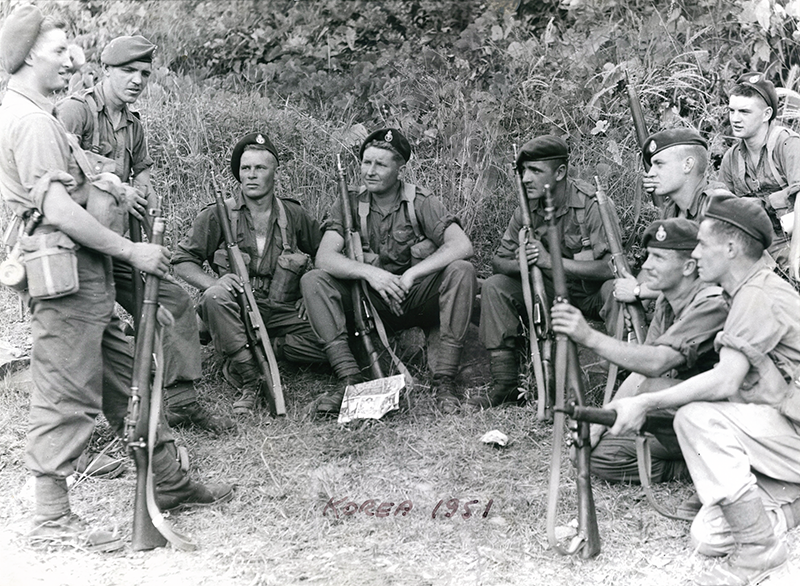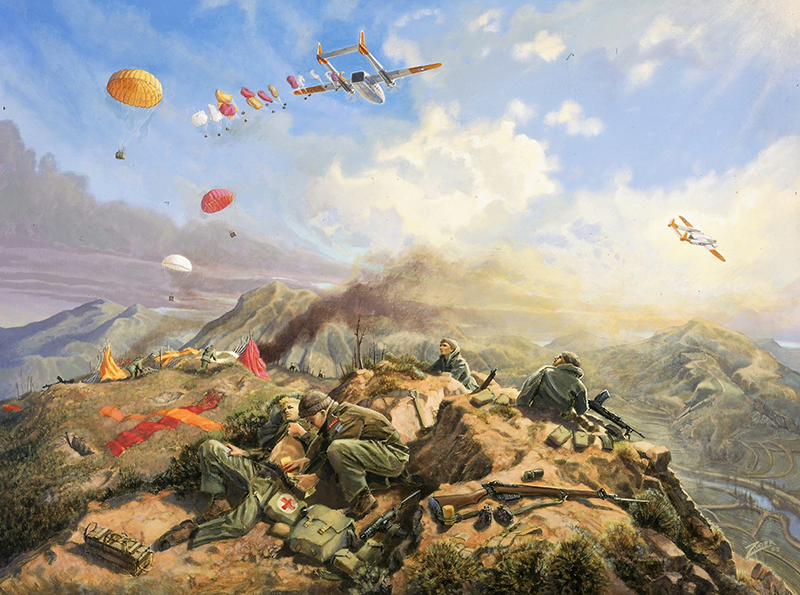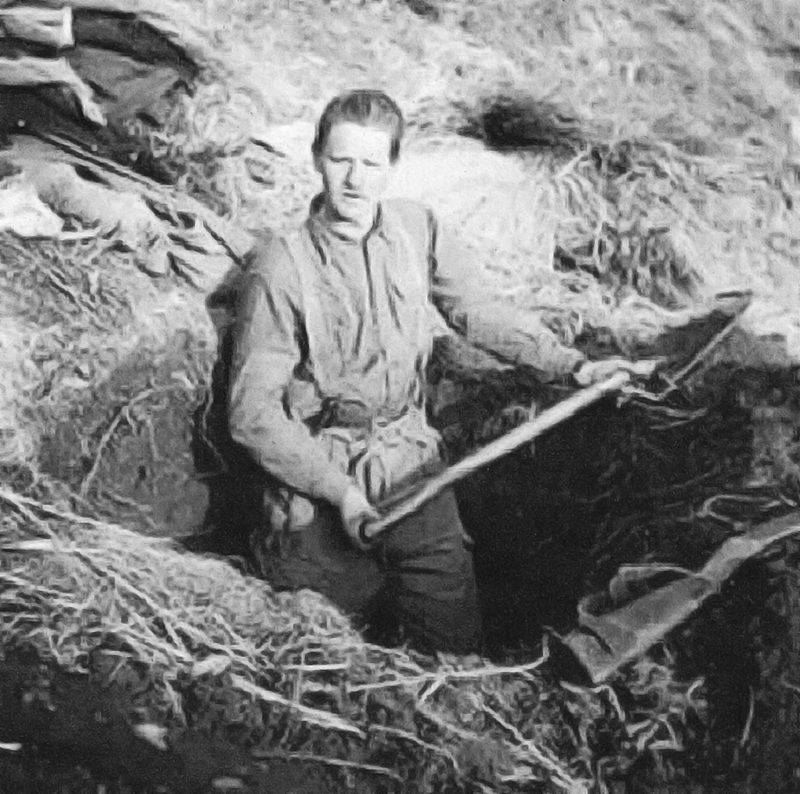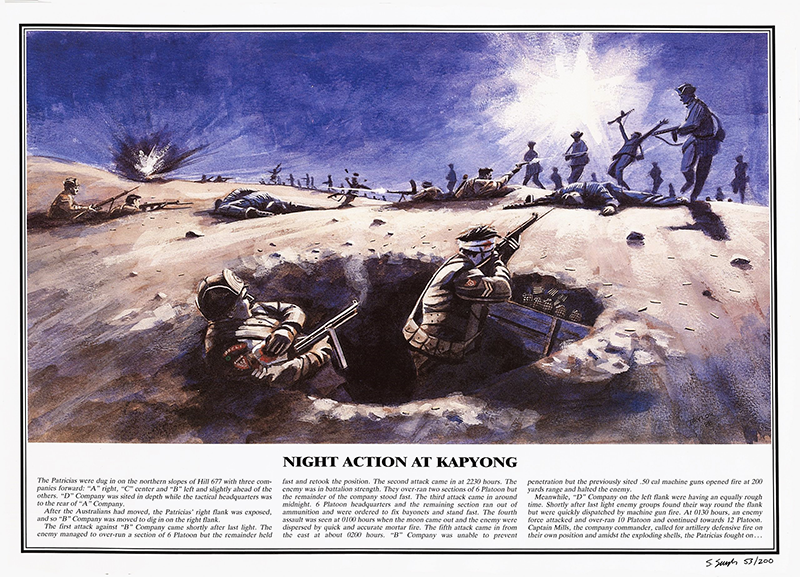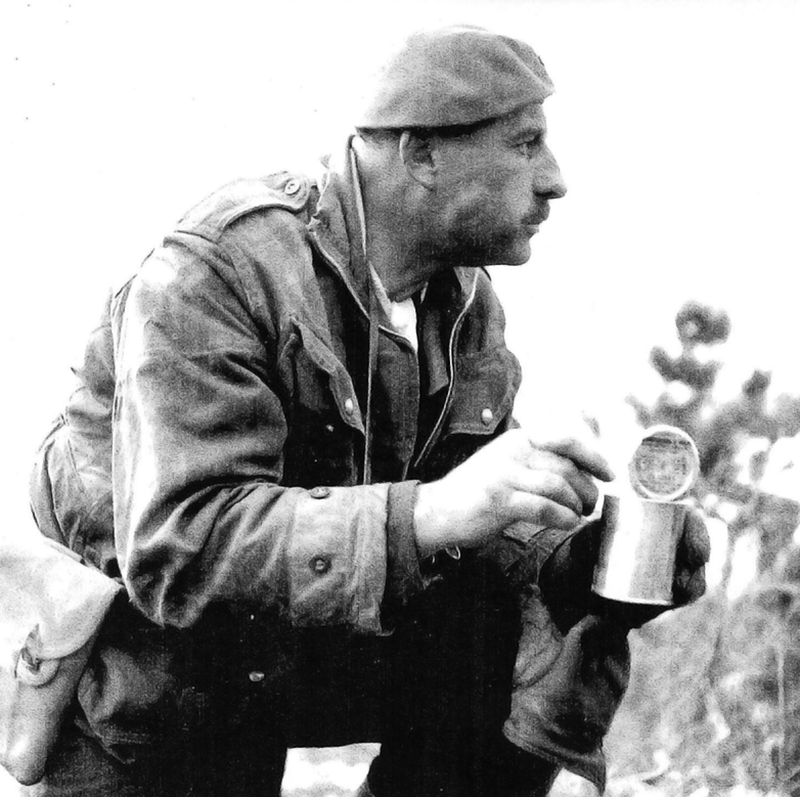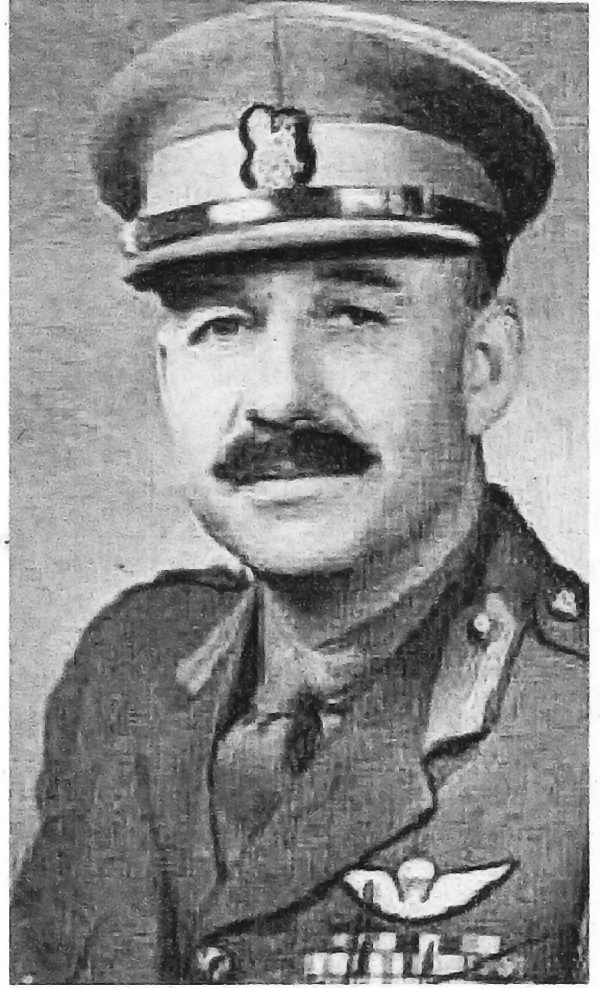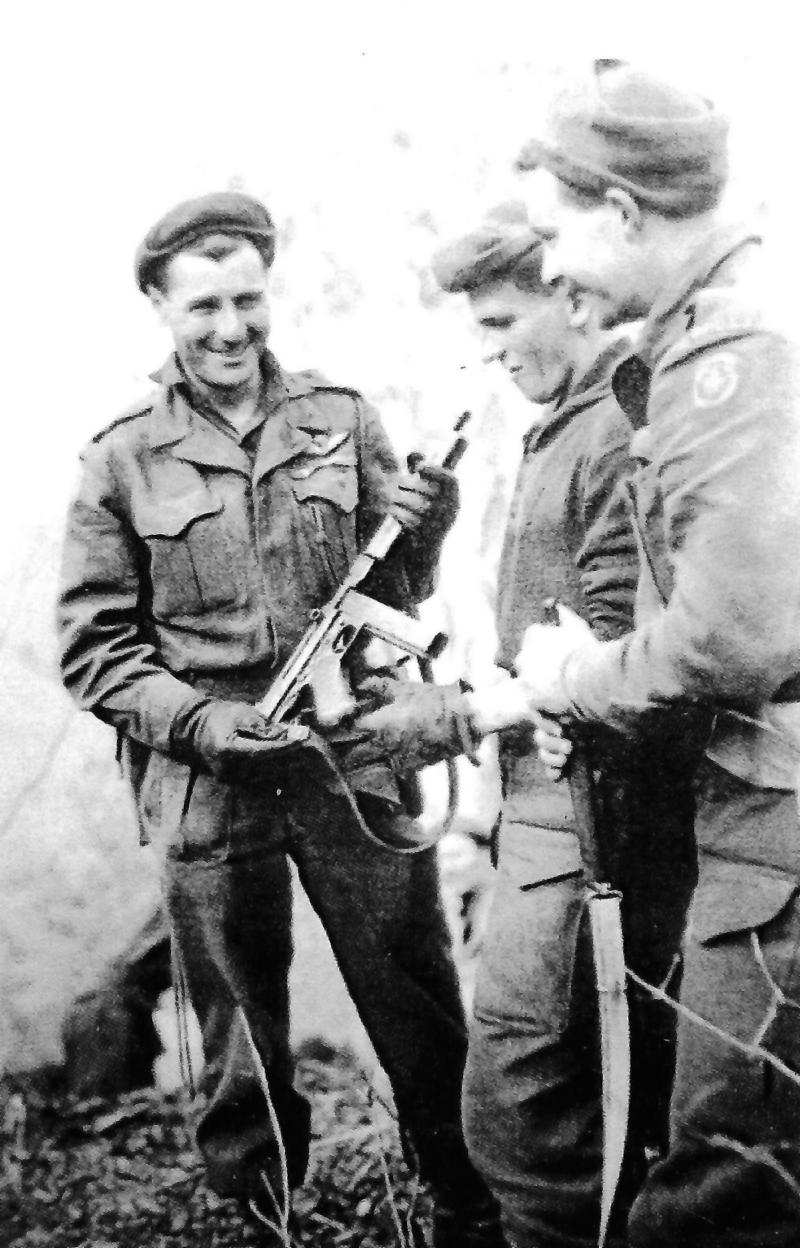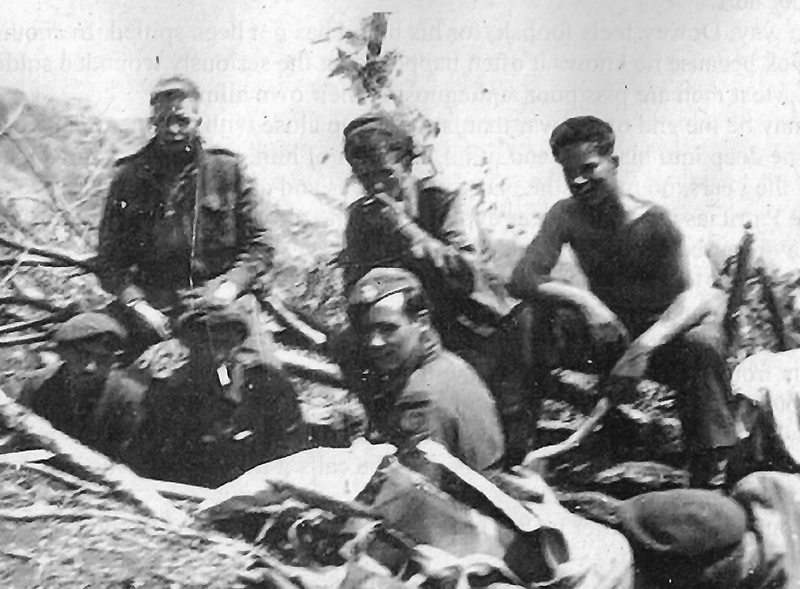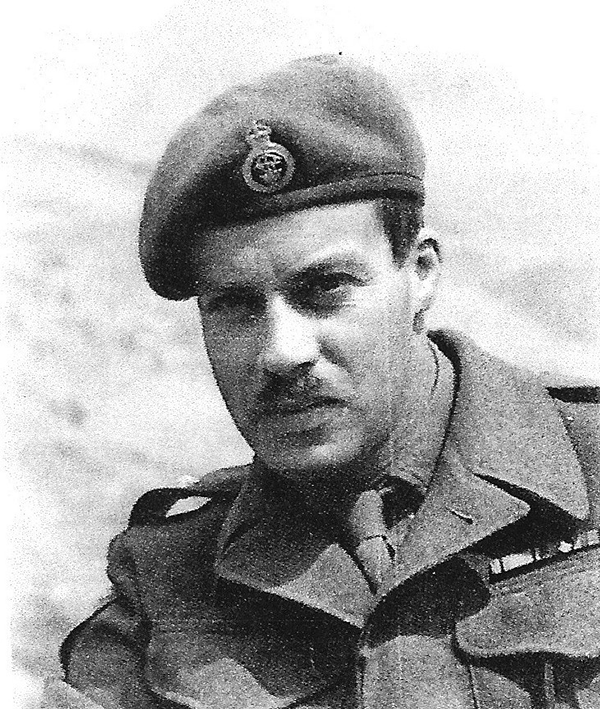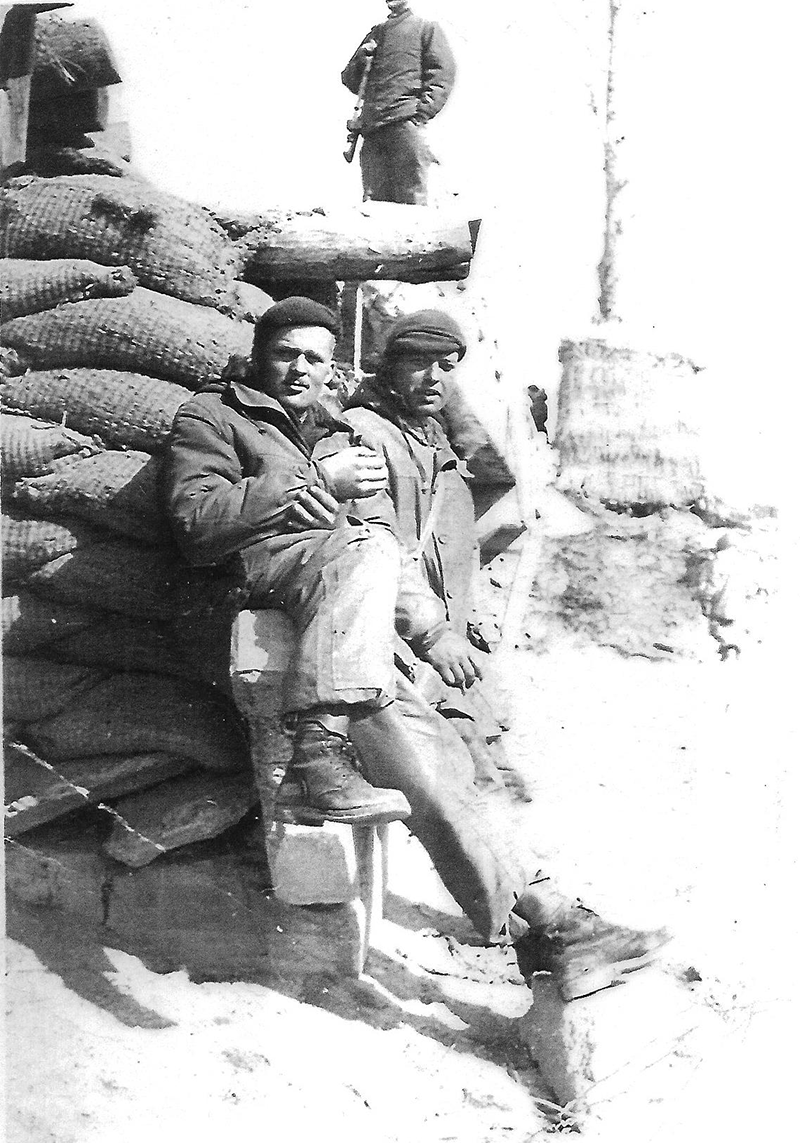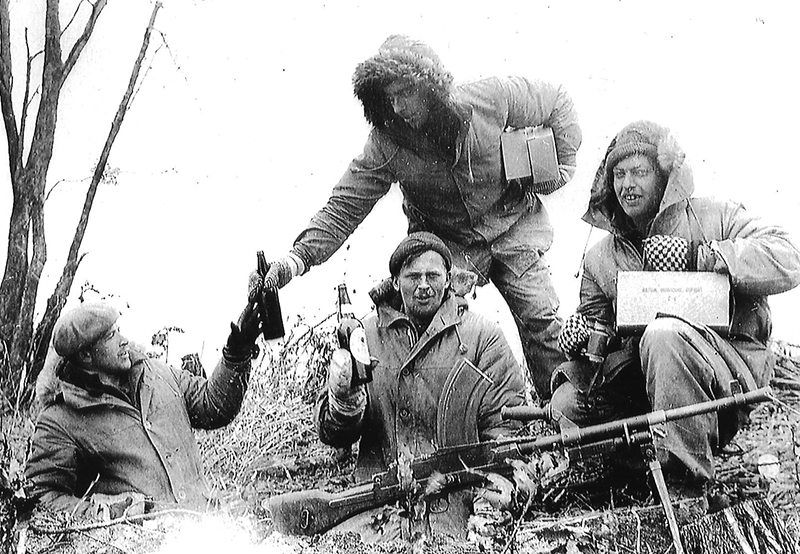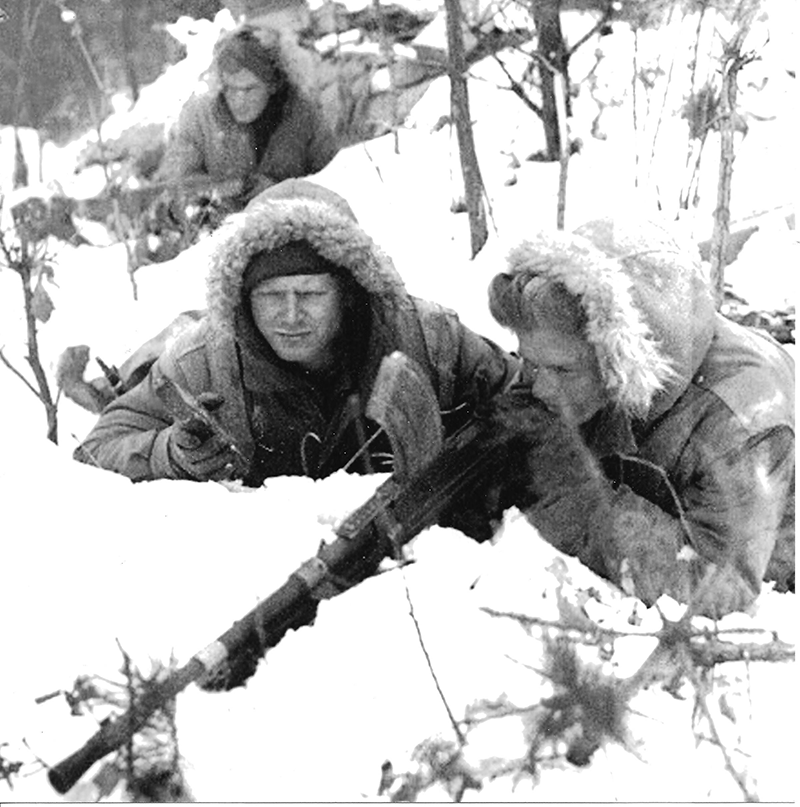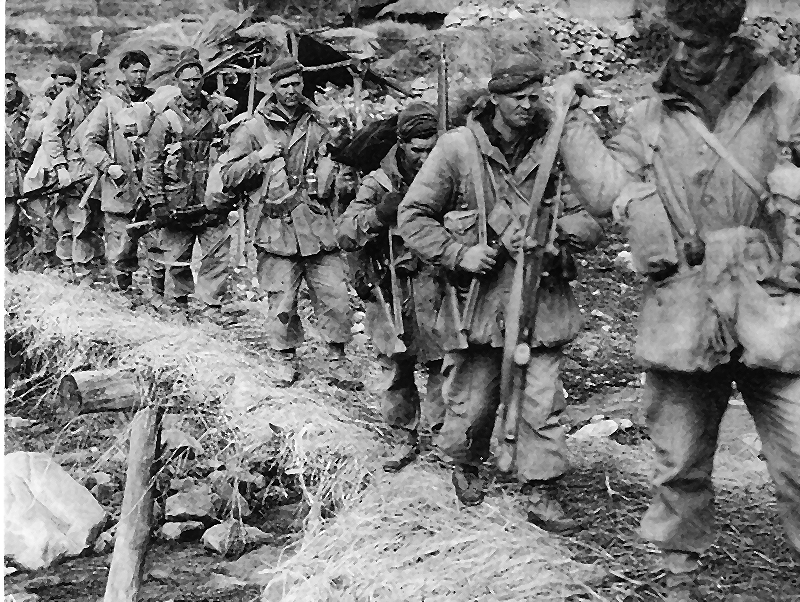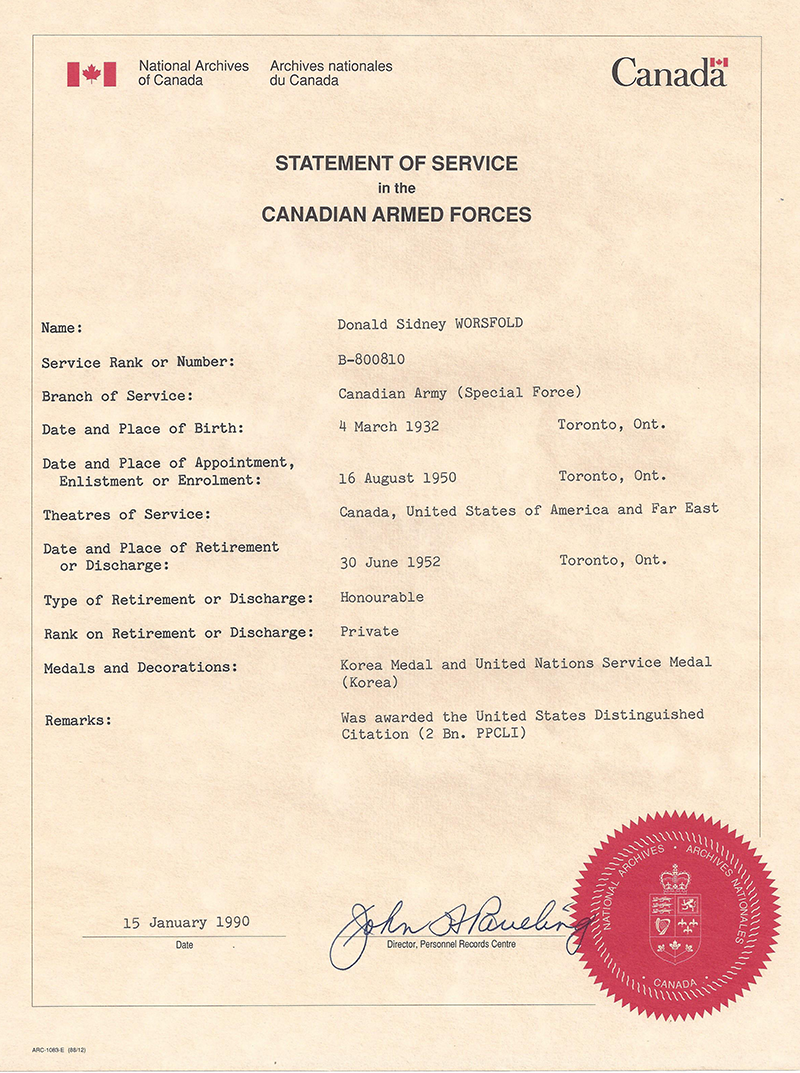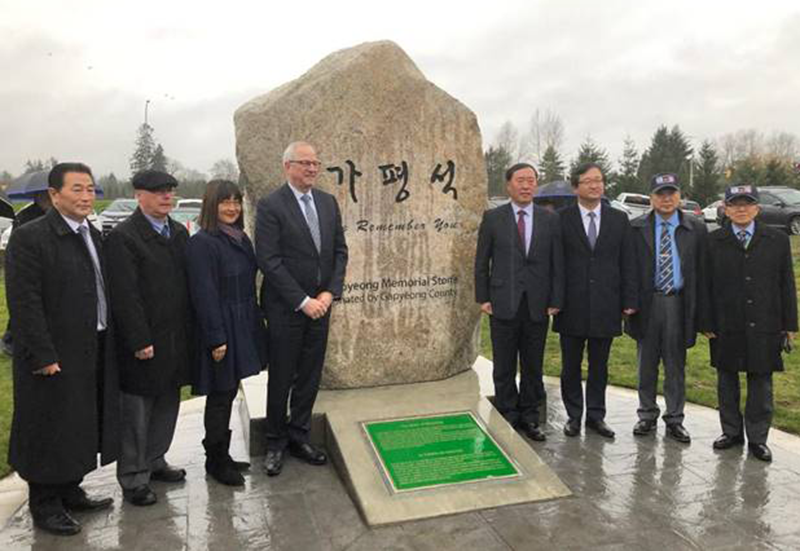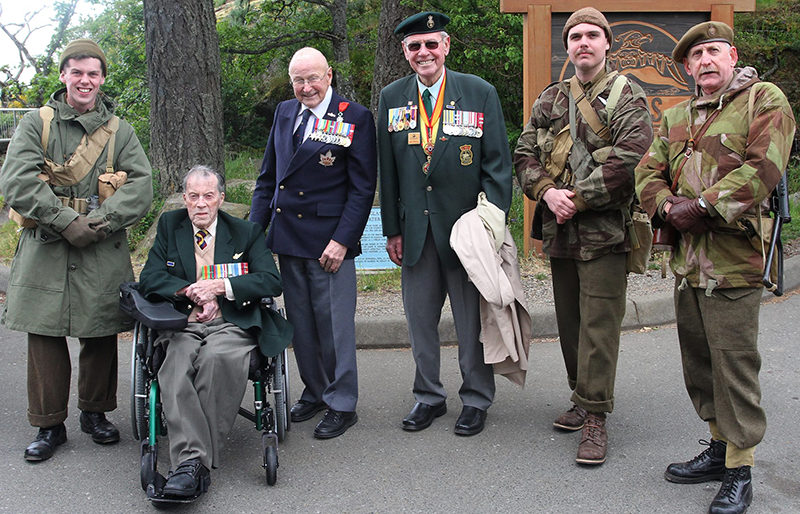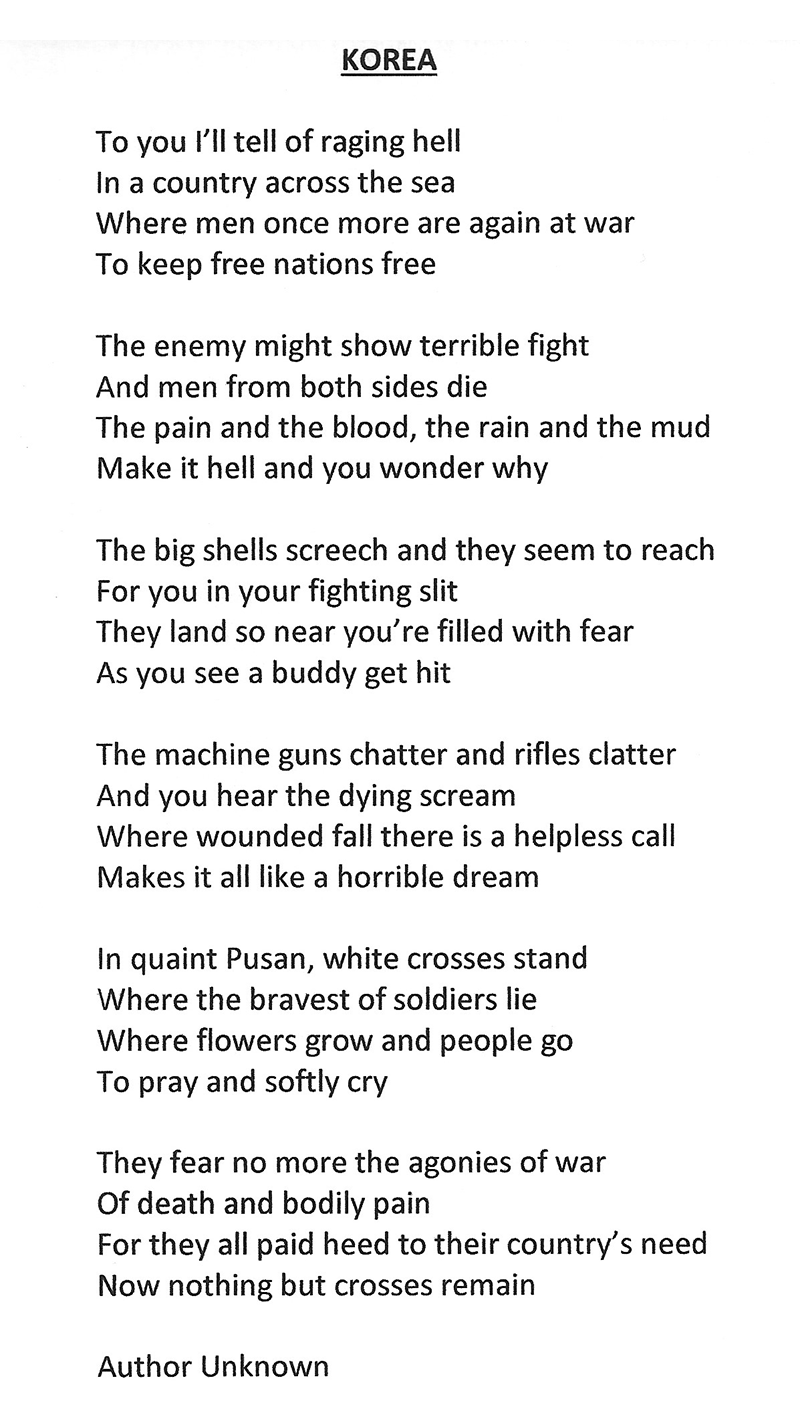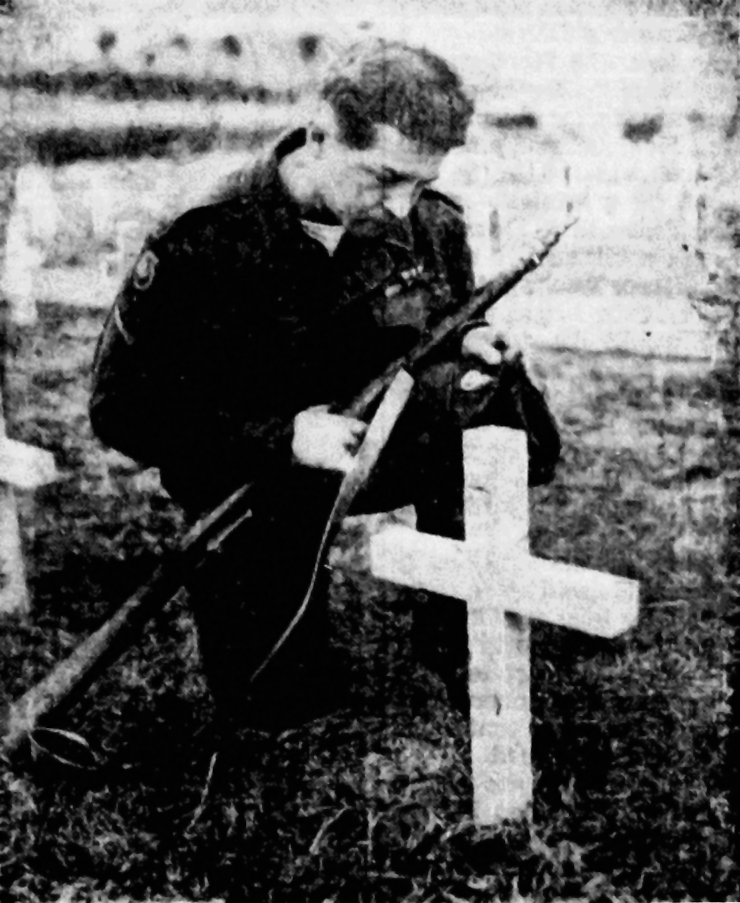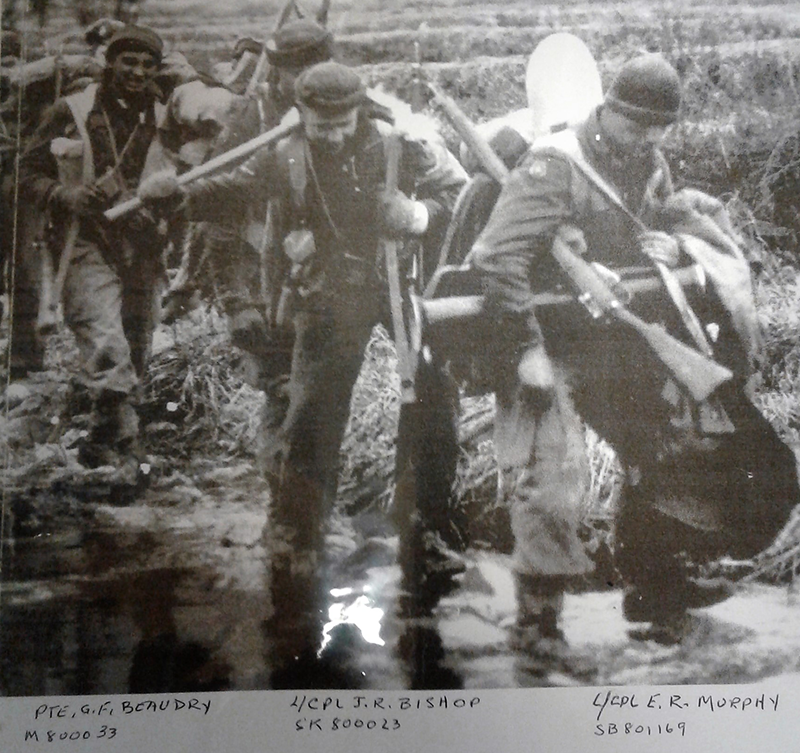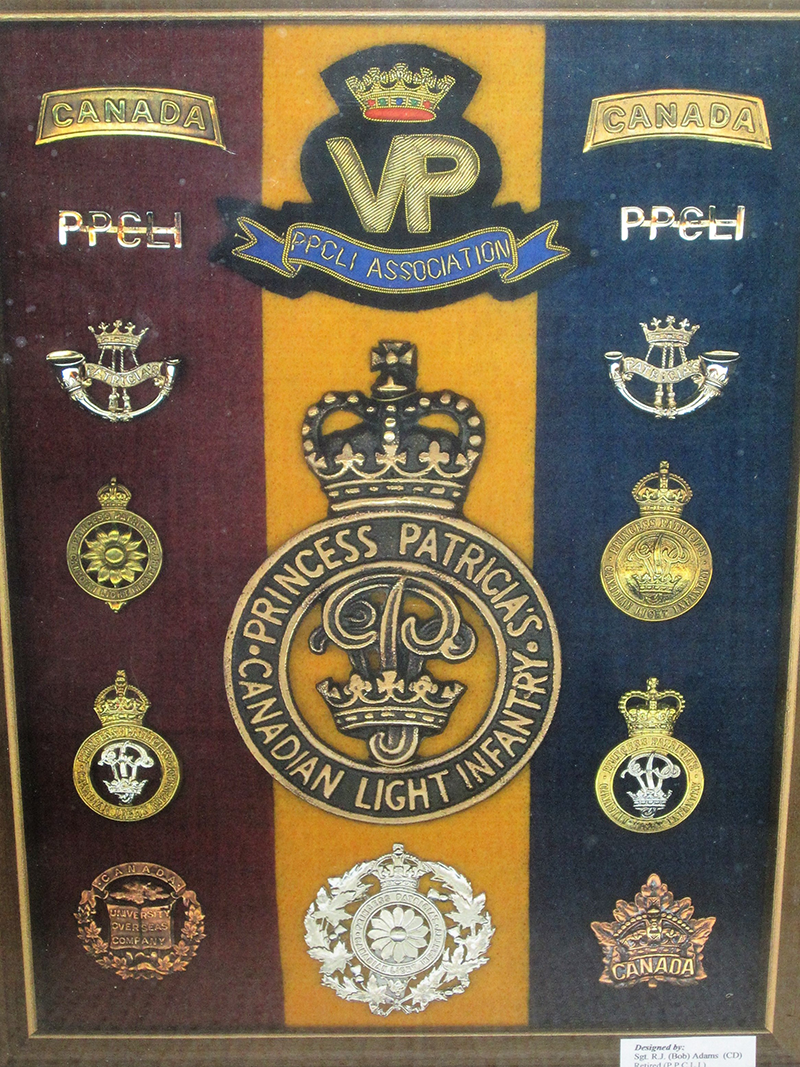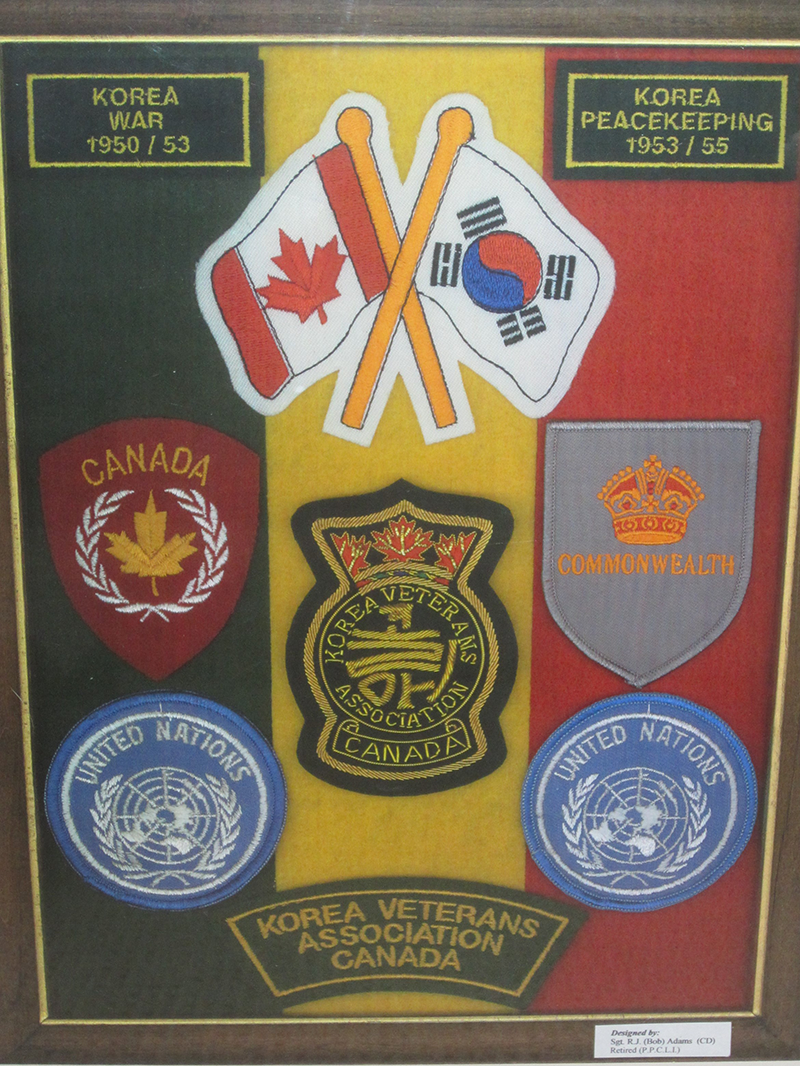 |
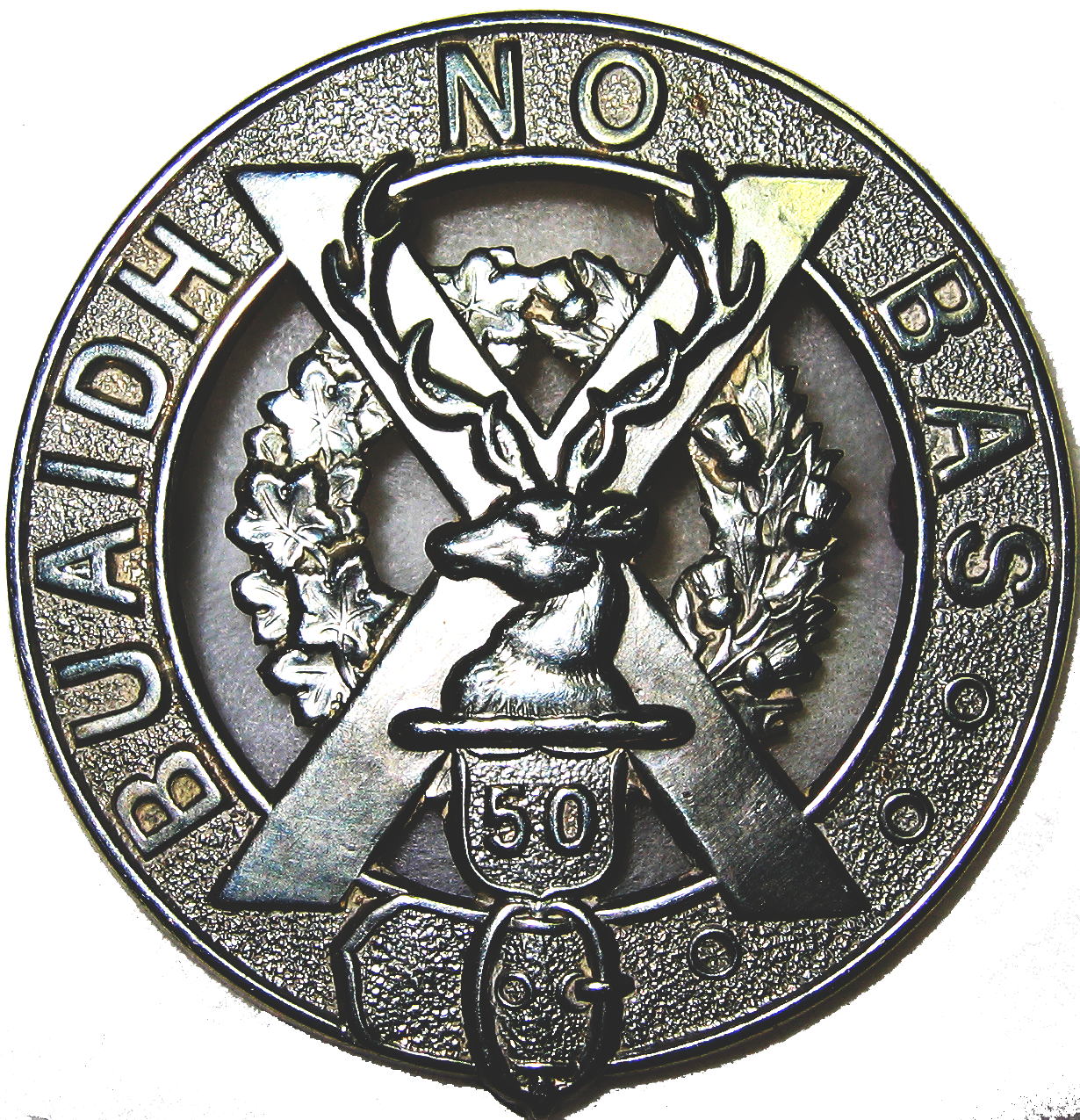 OPCMHVisitor No.: |
HISTORY OF WORK POINT BARRACKSby Jack BatesSPECIAL REPORTBATTLE OF KAPYONGDecember 5, 2021 THE BATTLE OF KAPYONG – 70TH ANNIVERSARY – APRIL 24/25, 1951 During the Korean War, which has been called a “Conflict,” a “Police Action,” and by many others in particular its veterans, “The Forgotten War,” the BATTLE of KAPYONG stands out as most pivotal in terms of the final outcome of the war. If the Chinese Communist Forces had prevailed, the South Korean capital city of Seoul a few miles away through the Kapyong River Valley, would have fallen to the invading forces for a second time. This would have been a costly defeat for South Korean and United Nations forces. The future of the United Nations, United States lead intervention, was in serious jeopardy. HILL 677, near KAPYONG, the site of the crucial and decisive defensive battle, was occupied by the Second Battalion, PRINCESS PATRICIA’S CANADIAN LIGHT INFANTRY. 700 strong at that time, under the command of Lt. Col. Jim Stone, a World War 2 infantry veteran, 2 PPCLI held their positions on the hill against fanatical waves of attacks by an estimated 5,000 to 6,000 Chinese Communist Forces. Defending the “knob” with machine gun fire, grenades, artillery and mortar fire, including hand to hand fighting amid the horror of close – combat warfare, for around 10 hours, 2 PPCLI maintained control through-out the darkness until the assaulting forces had been stopped. This gallant stand by the battalion in its defensive strategy by Lt. Col. Stone, and reactions during the battle, along with the initiative of Lt. Mike Levy, who called for and directed the “Danger Close Fire” on his own location, were highlights of the battle. This short but very intense and strategic battle was recognized by the Government of Canada, and in doing so, resulted in the Battle Honour "KAPYONG" being awarded to the PPCLI. The following compilation illustrates a cross section of the 2nd Battalion, Princess Patricia's Canadian Light Infantry, before, during the Battle of Kapyong, and afterwards, with a touch of the present:
Transcribed below are the 2 PPCLI war diary entries from April 24 and 25, 1951:
There were numerous individual acts of combat intensive bravery by members of 2 PPCLI and it could be considered that other “Pat’s” personnel were deserving of official recognition for outstanding courage. The battle casualty list included 10 (12) men killed, and 23 (35) wounded, under combat conditions from 2130 hrs on the 24th to 0900 hrs on the 25th. (April 23 – April 25). The twelve soldiers killed at Kapyong are as follows: Private MS Carr, age 29; Corporal GR Evans, age 23; Private LT Fielding, age 23; Private LP Gladu, age 19; Private CA Hayes, age 21; Private JM Lessard, age 23; Corporal E MacAshill, age 23; Private BM Macdonald, age 20, Private WJ Marshal, age 22; Private RGH Tulver, age 26; Private RL Walker, age 23; Private TB Wotton, age 22. Honourable mention must be made of the 16th Field Regiment, Royal New Zealand Field Artillery, (RNZA) for without their dedicated and pin pointed artillery fire, the battle outcome would have been negative for the defence of the Kapyong Valley and the route back to Seoul, let alone the 2nd Battalion PPCLI, and the United Nations efforts to save South Korea.
Lt. Mike Levy, was instrumental in recommending Private Ken Barwise for the MM for his outstanding courage during the battle. He received the award eventually in February 1952.
16 FIELD REGIMENT’S KOREAN EFFORTS RECOGNISED Lt. Col. M Boggs, Commanding Officer of 16 Field Regiment, has been presented with a citation by the Republic of Korea’s Minister of Patriots and Veterans Affairs Hon Sung Choon recognizing the regiment’s service and heroism during the Korean War. From the 22 – 25 April 1951, massed waves of communist soldiers were repulsed using a combination of infantry holding ground and artillery fire support. At times gun fire was directed onto friendly infantry positions as it was the only way to break up attacks, and by 26 April the communist forces had withdrawn. nzdf.mil.nz/news/media-releases/2011 PTE. W.R. MITCHELL MANITOBA SOLDIER TOPS LIST FOR BRAVERY AWARD IN KOREA One-Man Army OTTAWA – A one man army who fought until he could hardly stand topped the names on a list of five Canadians decorated for gallantry in Korea. He is Pte. Wayne Robert Mitchell of Virden, Man., a 21 year old former Hydro worker whose “extra-ordinary courage” in helping fight off an overwhelming Chinese attack during their April offensive brought him the coveted Distinguished Conduct Medal. Four other men with 25th Brigade units – Mitchell is a member of the 2nd Battalion, Princess Patricia’s Canadian Light Infantry – were awarded the Military Medal. In addition, 11 officers and men, all but one still alive and in Korea, were given Mentions in Dispatches. Citations for the five gallantry awards all bespoke unusual bravery under fire but the gallantry of Mitchell was tops. Despite two wounds, he Bren-gunned one “overwhelming’ Red assault to a halt largely by himself, carried a wounded man to safety despite a wound of his own, rushed a Chinese position firing the Bren from the hip to relieve a group of wounded men who were pinned down, covered his platoon’s withdrawal by moving from place to place under fire, and refused to be evacuated after four enemy assaults. He stayed at his post through that long night of April 25 at KAPYONG, close to his Bren. “At daylight,” said the citation, “Pte. Mitchell could hardly stand for the loss of blood.” He was flown back to medical care by helicopter. The Military medal winners included three artillerymen, all of them drivers for forward observation officers, the men who go up with the infantry to see that they get supporting gunfire when they need it.
BILL BOSS C.P. Staff Writer With the Canadians in Korea When the war in Korea broke out in 1950 Boss became the leading Canadian journalist and largely shaped the Canadian perception of the war, as many Canadian newspapers at the time relied heavily on the Canadian Press for their coverage. Boss was sent to Busan, South Korea with the Princess Patricia’s Canadian Light Infantry and immediately wanted to diminish his reliance on military authorities so that he could go to the places we wanted to report from, without censorship. Boss acquired copious amounts of Scotch, which he traded for a tent, generator, trailer and Jeep (later known as the “CP Jeep”) so that he was able to travel separately from the military. Boss went on to cover every battle in the Korean War involving Canadian forces, including the Battle of Kapyong, the Battle of Chaum-ni and the Battle of Maehwa-San. Two Newspaper Accounts of The Battle by Bill Boss Follow: COLONIST PATS FIGHT RED CHINESE TO STANDSTILL Bill Boss, Canadian Press correspondent with the Princess Patricia’s Canadian Light Infantry in Korea, writing the first detailed report on today’s action. Under censorship regulations he cannot at the moment mention Canadian troops, the Patricia’s, or the home town of the man he interviews. (Editor’s note – Though censorship regulations forbid correspondents in the field mentioning it, it is presumed Mr. Boss, Canadian Press correspondent in Korea, refers in this article to the Princess Patricia’s Canadian Light Infantry). By BILL BOSS WEST CENTRAL SECTOR, KOREA. April 25 (C.P.) United Nations mountain warriors won their spurs today, holding their front and refusing to budge even though outflanked and encircled. It was a knock-down, drag-out battle with wave upon wave upon wave of Chinese Communists who did everything but drive them from their positions. These United Nations troops are on the West Central sector northeast of Seoul. Look at any up-to-date battle map and the thick burr of resistance to the Communist onslaught is in the centre. Cut off, encircled, these United Nations troops fought on and by late morning today had cleared the enemy from their rear, had beaten him off their flanks and held him on their front. FAMILIAR PROCEDURES The Chinese employed all their familiar battle procedures in the attack — whistles, bugles, a banzai chorus, concerted action on the word of command and massed assaults followed one another in swift succession. This was familiar only by description for these United Nations troops who until now had fought mainly an advancing war against token resistance. Now it was grim reality. But they held. While others on the flanks were overwhelmed by sheer weight of numbers, they stayed steady as rocks. The Red’s attack materialized in force at 10 p.m., Tuesday. One sergeant said of the enemy soldiers: ‘They’re quiet as mice with those rubber shoes of theirs and then there’s a whistle. They get up with a shout about ten feet from our positions and come in. The first wave throws its grenades, fires its weapons and goes to the ground. It is followed by a second which does the same, and a third comes up. Where they disappear to I don’t know. But they just keep coming.” On the position held by that sergeant’s company the Chinese kept coming until 4 a.m. By then the forward platoon had exhausted almost its ammunition. The sergeant hurled his bayonetted rifle like a spear at his enemy. While two gunners stood up and gave covering fire from the hip, the remainder withdrew — but only 50 yards. There the company continued the fight, dividing the remaining ammunition and holding out until the enemy pressure relented. I counted 17 dead Chinese within inches and feet of those troops today and approximately 50 graves of enemy buried in the heat of battle. There were uncounted enemy dead where an intended rear and flank attack was thwarted. Another company fought at close quarters against waves of Chinese troops. This company shot and grenade the enemy until its ammunition ran out. Then a young captain fighting his first action as company commander gave the order: “Get into your slit trenches. Get well down. Stay there.” He then demanded artillery and mortar fire. Guns and mortars rained hell on that hill from 2 a.m. to 6 a.m. today. And when it was over the Chinese had had enough. They withdrew down northward and dug in only 100 yards away. UNKNOWN NEWSPAPER EPIC ACCOUNT OF CANADIAN STAND WHICH STOPPED RED ATTACK COLD (The following account of Canadian action in Korea was delayed by censorship which prevented the release of unit identification during a critical period.) By BILL BOSS C.P. Staff Writer - With the Canadians in Korea. (CP) – Canadians fought until their ammunition was exhausted, then hurled their rifles with bayonets attached like spears into the attacking Chinese when the 2nd battalion, Princess Patricia’s Canadian Light Infantry stopped the latest Chinese offensive cold in its tracks in Korea’s west central sector. Brunt of the initial attack was borne by a company under Major Vince Lilley of Hamilton, when the Chinese advanced wave upon wave to storm the Canadian positions. The Canadians were guarding the approaches to the vital Chun-chon-Seoul highway, in the hills three miles to its north and near the villages of Kail and Cheryoung.
They took their positions when the Chinese troops were streaming back from a front that had sagged 20 miles in the initial 25 hours, a retreat so disorganized that the vanguard of the Chinese force got in among them and into the holding positions established by the 27th British Commonwealth Brigade. BOGGED DOWN ultimately by a stubborn British and Australian stand, April 24th, the Chinese diverted their weight in the sector to an assault on the hills held by the Patricia’s. The first slit trench attacked in the sector was commanded by Cpl. G.R. Evans. It was on the hump of a hog’s back spur occupied by a platoon under Lieut. Harold Ross of St. Catherines, Ont., and jutting out from the main line of Lilley’s ridge. (Cpl. Evans, who enlisted in Vancouver and whose next-of-kin live in Norwich, Norfolk, England, was reported killed in action in a casualty list issued at Ottawa May 1. Lieut. Ross apparently had recovered from wounds suffered earlier in the campaign. He was listed as wounded in the first Korean casualty list issued at Ottawa, March 2. It listed his next-of-kin as his father, Henry Ross, Winnipeg.) Said Sgt. Roy Ulmer of Castor, Alta., Ross’ platoon sergeant: “Just before dark we saw them coming out of the hills to the north. But once night fell, we lost sight of them. “They’re good night fighters, and are well on top of you with those rubber shoes of theirs before you know it; quiet as mice. “They came in on Evans first. He spotted them just as the first wave was coming in. He put up a fire fight that lasted an hour and held them off. “THEN THEY tried McLennan’s (L/Cpl. Neil McLennan of Ottawa). They got on top of Mac’s and he opened up and held them off until one of his men was hit in the stomach with a grenade. All the time they were mortaring us — just to keep us interested. Mac’s men brought the wounded man back to platoon headquarters, where they jumped into the slit trenches and fought with us from there.” Still sleepy after the battle, grimy and unshaven, Ulmer, a former company-sergeant-major with the Loyal Edmonton Regiment during the Second World War, continued: “They would keep on coming in waves. Just like the description we’d heard. “There’s a whistle, they get up with a shout about ten feet from our positions and come in. “The first wave throws its grenades, fires its weapons and goes to ground. It is followed by a second which does the same, and a third comes up. Where they disappear to, I don’t know. But they just keep on coming.” — BILL BOSS
United States Presidential Unit Citation - 2 PPCLI In recognition of the “outstanding heroism and exceptionally meritorious conduct” displayed at the BATTLE of KAPYONG, a “United States Presidential Unit Citation” was awarded to 2 PPCLI, 3 RAR and the 72nd US Heavy Tank Regiment.
Click here to view the US Presidential Citation as a PDF. Travel to Korea After training at Sarcee Camp and Camp Wainwright, the finally at Fort Lewis, Washington, 2 PPCLI left Seattle, Washington, USA, November 25, 1950 for Pusan Harbor, Korea, arriving December 18th to join the 27th British Commonwealth Brigade. They sailed on the USNS “Pvt. Joe P Martinez” and on board a newspaper titled the “EAGLE - LEAF” was published. Below is a copy of the paper on the “12th Day Out,” December 7, 1950. Note the items involving Lt. M.C. Edwards.
Battle Map of 2 PPCLI at KAPYONG 24 – 26 April 1951
2 PPCLI Nominal Role for 24/25 April, 1951 Click here to view the 38-page document as a PDF ER Murphy – L / Cpl - A Company – 2 Platoon - at the Battle of KAPYONG Russ Murphy annotated the 2 PPCLI nominal role in 2011 with as much information as he could secure at the time. He validated the names, indicated the individual company and platoons, and functions within the battalion, along with the dates of death at the time. Unfortunately, Russ passed away himself on November 6, 2018. The Victoria Branch of the PPCLI Association was well represented at his farewell service in Victoria. Russ lived on Pender Island at the time and was 89 years of age. This nominal role is available at the PPCLI Museum /Archives in Calgary. Vancouver Sun Vancouver Soldier First Korea Casualty RSM James D. Wood, Killed in Mine Mishap, Had Distinguished Career First Canadian soldier to die in the Korean campaign is a Vancouver man, RSM James Dean Wood, 35, whose father, J.S. Wood, lives at 3539 Marshall. The Warrant Officer was fatally wounded during a mine demonstration he was giving the Princess Patricia’s Canadian Light Infantry company sergeant majors. He died less than 24 hours later. FOR BRAVERY IN ITALY RSM Wood, 17 years a soldier, won the Distinguished Conduct Medal for exceptional bravery in Italy. He went overseas with the PPCLI in the second world war, serving in Italy. October 20, 1944, when he crossed the Savio River with 18 men under heavy fire, he swam back to bring up a radio. The radio was shot from under his arm. Machine gun fire from an enemy dugout pinned his men down and he rushed the dugout with hand grenades, captured five of the enemy and brought back a wounded Canadian. It was at Savio River that Ernest “Smokey” Smith won the Victoria Cross. BROTHER DIED AT SALERNO Wood’s brother, Sgt. Al Wood, was killed outside Salerno, Italy, in 1945, while attempting to remove a mine from the road. Two other brothers, Ian, 2012 Gray, Burnaby, and Bill, 820 East Thirty-Seventh, Vancouver, were also in the fighting. Jim’s wife, Norma, resides in Calgary. They have no children. William Boss, Canadian Press staff writer with the Pats in Miryang, Korea, where the unit has been undergoing training, says that RSM Wood was giving the company sergeant majors a mine demonstration. THOUGHT IT WAS A DUD The mine did not go off when the soldier fired it, he said. Apparently thinking it was a dud, he picked it up and was throwing it away when it exploded. He suffered loss of his right hand and forearm, as well as major neck injuries and died less than 24 hours later in hospital.
A famous painting by Canadian artist Ted Zuber, depicts troops from the 2nd Battalion, Princess Patricia’s Canadian Light Infantry, holding on “the knob,” the pinnacle of the great Hill 677 that the enemy tried to capture during the Battle of Kapyong in April, 1951. Ammunition, food and medical supplies are being air dropped by the U.S. Air Force, as the Canadians, for several hours, were cut off by infiltrating enemy units. The Kapyong River is depicted on the right side of the painting. The company medic represented in the painting actually was Private Donald Copley, who was Mentioned in Dispatches for his bravery and unwavering service. After the war he attended university and medical school, then practiced medicine for many years. (The artist Ted Zuber served in Korea in 1952 and 1953 as a bren gunner and later a sniper with the 1st Battalion of the Royal Canadian Regiment) At the PPCLI Archives there are eleven photographs of 10 Platoon, Dog Company at KAPYONG. See Donald Copley Fonds (C70-1.1;98.05)
Korean War Art by Katherine Taylor – Canadian War Museum
The Patricia’s were dug in on the northern slopes of Hill 677 with three companies forward: “A” right, “C” centre and “B” left, and slightly ahead of the others. “D” Company was sited in depth while the tactical headquarters was to the rear of “A” Company. After the Australians had moved, the Patricia’s tight flank was exposed and so “B” Company was moved to dig in on the right flank. The first attack against “B” Company came shortly after last light. The enemy managed to over-run a section of 6 Platoon by the remainder held fast and retook the position. The second attack came in at 2230 hours. The enemy was in battalion strength. They over-ran two sections of 6 Platoon but the remainder of the company stood fast. The third attack came in around midnight. 6 Platoon headquarters and the remaining section ran out of ammunition and were ordered to fix bayonets and stand fast. The fourth assault was seen at 0100 hours when the moon came out and the enemy were dispersed by quick and accurate mortar fire. The fifth attack came in from the east at about 0200 hours. “B” Company was unable to prevent penetration but the previously sited .50 cal machine guns opened fire at 200 yards range and halted the enemy. Meanwhile, “D” Company on the left flank were having an equally rough time. Shortly after last light enemy groups found their way round the left flank but were quickly dispatched by machine gun fire. At 0130 hours, an enemy force attacked and over-ran 10 Platoon and continued towards 12 Platoon. Captain Mills, the company commander called for artillery defensive fire on his own position and amidst the exploding shells, the Patricia’s fought on. — S. Taylor 53/200. 1988. Buildings Named in Honour of Korean War Heroes Government of Canada News Release - June 15, 2015. Shilo, Manitoba. Three main buildings that make up Kapyong Barracks at CFB Shilo have been officially named in honour of three soldiers who served at the Battle of Kapyong. The main building (C – 106) has been named after Colonel Stone. As the “Special Force” was being established for the Korean War in July 1950, Colonel Jim Stone was chosen to command what would become the Second Battalion, Princess Patricia’s Canadian Light Infantry (2 PPCLI). By February 1951, 2 PPCLI was deployed as part of a UN response to a Chinese and North Korean Spring Offensive. Tasked with defending Hill 677 at Kapyong, his decisions and orders were instrumental in preventing the collapse of 2 PPCLI’s position from Chinese attacks on that very flank. For his powerful leadership, sound judgement and valour at Kapyong, he was awarded a third Distinguished Service Order. The maintenance and transport hangar (C – 105) has been named after Warrant Officer First Class Les Grimes. Affectionately given the nickname “Daddy” by the younger troops of the battalion, WO 1 Grimes served as the Regimental Sergeant Major of the battalion at the Battle of Kapyong. On 24 – 25 April 1951, his unwavering dedication and fatherly presence anchored the men of 2 PPCLI in their resistance to the Chinese onslaught. Building C -106 Annex is now named for Private Wayne Mitchell. The Pte Mitchell Annex is a purpose – built facility to house the Light Armoured Vehicle (LAV III and VI). Pte Mitchell was born in Virden, Manitoba and enlisted in the Canadian Army with 2 PPCLI in 1950. Soon after, he would find himself in Korea, where he would make his mark at the Battle of Kapyong. Despite his position being attacked by 100 Chinese soldiers, his valorous conduct became the stuff of legend. He was severely wounded, barely able to stand for loss of blood, and over-run by Chinese soldiers yet he defended his position and saved the lives of several of his comrades. Private Mitchell was awarded the Distinguished Conduct Medal, second only to the Victoria Cross. He was 19 years old at the time. The $39.4 million, 30,000 square-metre Kapyong Barracks was completed in 2004. The complex is composed of administrative, operational and training areas that include a base training support component, a maintenance and transport hangar, as well as a purpose-built facility to house the Light Armoured Vehicles (LAV III and VI).
KOREA IN RETROSPECT I sailed for Korea with the 2nd Bn, Patricia’s, in December of 1950 on the old converted Liberty freighter, the Joe P. Martinez, along with a thousand unhappy American National Guardsmen. In the battalion we were lucky with our chaplains: Father Valalee had been a missionary in China for seventeen years while our Captain Nunn had served in North Korea. Their talks on our twenty-three-day long voyage made us quite familiar with the country and its history; what they didn’t prepare us for were the people. At the time of our arrival, Christmas 1950, the North Koreans had taken all of South Korea with the exception of a final stronghold around the Port of Pusan. Then came General MacArthur’s brilliant counter-stroke at Inchon that force the North Koreans to retreat or be cut-off and now came something our chaplain’s talks hadn’t prepared us for – the people. During the latter half of my time in Korea I served as battalion Quarter-Master which afforded me an opportunity to see the country and to meet the people; something denied our troops in the line. I could only be impressed with the faith and fortitude of all I met. In 2009 I returned to Korea as one of the many guests of a people grateful for their freedom. Having known the oppression of Japan for over forty years and then the threatened yoke of communism, their thankfulness is very understandable – and now – what of this Korea I was returning to? All the casualties, the suffering, the destruction? One look at the Korea of today and the answer is a resounding “yes” – we didn’t lose our men in vain. This new Korea, however, didn’t just rise up out of the ashes like a phoenix, - No! – there had to be a leadership with the vision of what a new, rebuilt Korea should be – then the engineers, architects, businessmen and others who could take that vision and turn it into a practical plan – and finally, and most importantly, the people, who through their hard work and dedication would bring that vision, that plan, to fruition. And so I close with these words for the people of Korea – “Well Done.” — Murray C. Edwards, Major (ret’d).
The Man Who Saw It Coming SM 800015, L/Cpl HR Croker – Tac HQ at the Battle of KAPYONG, April 24/25, 1951 Ray Croker, a radio operator at Tac HQ was listening in on messages being sent from other units – American, British and Australian forces – in the area, to higher command back behind the lines at the dawn of April 24th. “For two hours I plotted those positions with pins on my map. When the last report came in, I studied it.” Croker saw the pattern of his pins was becoming a circle, and 2 PPCLI was in the centre of it. He called for Colonel Stone, who checked all the co-ordinates, re-plotting them all himself. 2 PPCLI was surrounded. “By God, we could get knocked off (the hill),” he said. Stone had yet to deploy his soldiers into a brilliant defensive layout that would later be studied as a masterpiece. That deployment would come in the hours ahead. His immediate priority was to make sure his vehicles would not be taken in a sudden Chinese onslaught. “Take the lids of the Jerry tins (gasoline cans),” Croker remembers Stone’s sharp orders. “Get them off the vehicles, put them in front and put matches on top of them. If you see Chinese coming over the hill, light them.” The torching did not become necessary. Thanks to Croker’s imagination and initiative, Stone was given an early warning of the nature of the growing peril. At about 7 a.m., Croker goes off duty, covers a few yards; and is shot in the foot by a Chinese sniper. His war ended quickly, driven in a field ambulance to a medical team from India and evacuated by helicopter to an American MASH unit. Recuperating in Japan, the army wanted to send him home, But Croker wanted to go back to his unit. The army won; home it was. No Canadian uniforms were available in Japan so they dressed him in Australian kit someone found, and when he finally arrived back in Edmonton, no one recognized this strange man in the strange uniform. Ironically, Croker is not officially listed as a casualty in the battle. The figure of 10 killed and 23 wounded accounts for those hit between the evening; 2130 hours on the 24th to 0900 hours on the 25th. Croker, the soldier who first saw the Chinese attack taking shape, was shot a few hours before the official tally begins. The above narration is taken from an interview on April 15, 2011 by Dan Bjarnason, former CBC television correspondent, and author, and is chronicled in his book “Triumph at KAPYONG, Canada’s Pivotal Battle in the Korean War.” At Last It’s a War For decade, news media consistently referred to the war in Korea as the “police action” or, a “conflict,” as if the bloodshed of two million military and civilian deaths did not qualify it to be called what is was – a full scale war. Journalists were not at fault. U.S. President Harry Truman committed American forces to combat without a formal or constitutionally mandated declaration of war. He also coined the phrase “police action.” 45 years after the cease-fire in Korea, the United States, which supplied by far the largest contingent of military personnel and “materiel” for the United Nations Forces, has rectified the problem. On September 22, 1998, U.S. President Bill Clinton signed an act of Congress declaring that the action in Korea, 1950 – 1953, hence forth will be known as the Korean War. Under the provision of the U.S. Government’s National Defense Authorization Act for the fiscal year 1999, voluminous government documents are in the process of being edited to replace references to the “Korean Conflict” with “Korean War.” President Clinton’s authorization of the foregoing barely produced a collective yawn in the general public. (the President after all, had other things on his mind in the fall of 1998, and consequently so did the media). It did however, give Korean War veterans a tool to rap the knuckles of any journalist who dares refer to the 1950 – 1953 war as a police action or the Korean conflict. KVA Newsletter It was in 1991 that the Korean War was officially accepted as a “war” by Canada and with that the creation of the “Canadian Volunteer Service Medal” for Korea to qualified veterans who served between 27 June 1950 and 27 July 1954. It has been a debate also as to whether a ribbon “numeric” for multiple tours in Korea would be authorized. Finally, on September 22, 1998, then U.S. President Bill Clinton, signed an ACT of CONGRESS declaring that the action in Korea, 1950 – 1953, henceforth will be known as the KOREAN WAR. Publications on The Battle of KAPYONG There have been many credible publications produced on the Battle of KAPYONG, but none more precisely detailed, researched and relevant than “BEYOND THE DANGER CLOSE” by Hub Gray, Lt. – 2 I/C Mortar Platoon, 2 PPCLI at KAPYONG, (D Coy – 12 Platoon Commander). SUBTITLE: “THE KOREAN EXPERIENCE REVEALED.” For any-one interested in the Battle of KAPYONG, this is a must read. Endorsed by M Gen B Vernon; Captain Peter Worthington, Toronto Sun; M Gen HC Pitts; Col J Barrett, USMC; L Gen Crabbe; M Gen CW Hewson; M Gen Lewis McKenzie. Message of Congratulations signed by Patricia Mountbatten of Burma and Foreword by General John de Chastelain – March 2003. Two booklets on the Korean War (with captioned photographs) have been written by Major (Ret’d) Murray C. Edwards, Captain and Quartermaster -Tac HQ - 2 PPCLI at KAPYONG. His accounts are based on his own first-hand experiences during the battle from his position at Tac HQ on Hill 677. His personal quest is the creation of a PPCLI Regimental legacy and historical inclusion for his late comrade in arms, Lt. Mike Levy. Murray Edwards will be 102 years of age on January 16, 2022, and lives at Broadmead Lodge in Victoria. Another book of relevance is “RIDEAU HALL” by Vince Courtenay, who also served with the PPCLI in Korea. The subtitle is “A Fast-Moving Documentary Novel About The First Canadian Soldiers To Serve In The Korean War.” First published in January 2011 for the author by the Korean War Veteran Internet News Publication as “LOVE and DUTY” - A Canadian Remembers The Korean War. Also by Vince Courtenay, a book titled "With the Princess Pats in Korea" November 2020. The PPCLI Regimental Manual Chapter 30 - “THE KOREAN WAR, 1950 – 1953” in 2020, now contains reference to Lt. Mike Levy and his actions at the height of the battle. In the 2008 Patrician, a 12-page article “A Personal Memoir of Korea” by Pte Mike Czuboka - 2 PPCLI Mortar Platoon (81 mm) at KAPYONG, recognized Lt. Mike Levy and his heroic role. Other publications from within the PPCLI ranks: John R Bishop - (Corporal A Company 2 Platoon) - April 2001 - “The King’s Bishop - A Canadian Corporal in Korea 1950–1951.” L/Cpl Davy - PATRICIAN November 1954, Page 20 - “KAPYONG”. Major GE Henderson CD - (Battle Adjutant Tac HQ) - PATRICIAN 1960–1961, Page 96 - “KAPYONG”. Major G Henderson (Ret’d) - Statement of Official Military Recognition for Lt. Mike Levy, 3 June, 1998. Col. JR Stone DSO MC - PATRICIAN 1973, Page 185 - “KAPYONG – A Speech by Col. JR Stone”. J. Farrell - PPCLI Association Newsletter - November 2007 - “His Selfless Action Helped Save Korea”. PPCLI Regimental History – 1919–1957 Volume III G.R. Stevens. Jeffery Williams - “Famous Regiments – PPCLI”. 1972. Jeffery Williams - “PPCLI 1914–1984”. 1985. Robert Hepenstall - “Find the Dragon” - July 1997. PPCLI Association Newsletter - Fall 2020. 70th Anniversary articles. PPCLI - Hamilton Gault Memorial Fund Student Bursaries 2021 - Major Mike Levy - "Kapyong Vet called Down Arty Fire on His Platoon". The Canadian Encyclopedia, with photos including a video, on March 31, 2018, revised their 2011 history of the “Battle of KAPYONG” to include the bravery of Lt. Mike Levy. The Esprit de Corps Magazine published two articles on Lt. Mike Levy: “The Battle of Kapyong Revisited” - April 2016 and “The Spirit of a Soldier” - May 2016. Les Peate, Korean Veteran, Past President KVA of Canada. “The War That Wasn’t – Canadians in Korea” 2005 PPCLI Association Fall 2021 Newsletter by Susan E. Evans, daughter of Lt. Col. Owen Browne, Captain of A Company at KAPYONG. Titled: The Battle of KAP’YONG 70th Anniversary. Embassy of Canada to Korea. Titled - KAPYONG 70 - April 21, 2021 Civilian authors have published credible books on the Korean War and particularly The BATTLE OF KAPYONG. Since 1999, David Burcuson, BLOOD ON THE HILLS, The PATRICIA’S; Ted Barris, DEADLOCK IN KOREA; Dan Bjarnason, TRIUMPH AT KAPYONG; Terrance Cottrell, THE BATTLE OF KAPYONG; William Johnston, FORTUNE FAVOURS THE BRAVE; Leif Gregerson, A HILL TOO HIGH; SK Roney, REMEMBERING A DARK CLASH OF TWO ARMIES, to name a few. All have referenced the “gallant and distinguished service in the field” of Lt. Mike Levy, detailing his initiative and selfless actions initiating and directing from the target area, the “danger close” air burst (shrapnel) artillery fire, by the 16th Field Regiment, RNZA. Videos Have Been Produced on The Battle of Kapyong to Name a Few A commemorative video titled “KAPYONG” produced by Screen Australia/Arcimedia with Film Victoria – 2011, graphically includes the heroic actions of Lt. Mike Levy. Veterans Affairs Canada - “Battle of Kapyong” – titled the danger close fire call “A Risky Move.” Historica Canada – “The Battle of Kapyong” – Jeremy Diamond – 2011. March 31, 2018. Valorcanada.ca – “The Battle of Kapyong” – 2019. Great Canadian War Stories - “Lt Mike Levy Recognition Delayed” - May 11, 2017. Valor Canada – “Battle of KAPYONG” - Nov 8, 2013. Youtube – “Battle of Kapyong” kwiteryabitchin - 27th Commonwealth Brigade - July 21, 2020. The War Amps – “KOREA – Canada’s Forgotten War” March 31, 2016. Narration by Wayne Mitchell DCM. Ken McCall - Canadian Hero The following images are from the Ken McCall Collection, B Company, 6 Platoon.
The Korean War has been called, "Canada's Forgotten War." Canadians don't know the names of the battles or the heroes who live among us. Kenneth McCall of Abernethy, Saskatchewan was one of those heroes. The United States Distinguished Unit Citation was awarded to the Second Battalion, Princess Patricia's Canadian Light Infantry for extraordinary heroism and outstanding performance of combat duties in action against the enemy near Kapyong, Korea on 24 and 25 April 1951. Ken McCall was one of those who received this award. On June 25, 1950 the North Korean army invaded South Korea. That afternoon in New York City, the United Nations Security Council voted to take action against North Korea. As a member of the United Nations, Canada was automatically involved. Canada did not declare war on North Korea maintaining that the operation was a police action. On June 30, 1950, United Nations command was established in Tokyo under American General Douglas McArthur. On July 12, three Canadian destroyers were sent to the waters around Korea to serve with the United Nations. The RCAF provided supply transporting supplies by air. By August, the Canadian government authorized recruitment of the Canadian Army Special Force (CASF). The CASF was part of an international response to North Korean aggression. When the Canadian Government put out an appeal for 1000 men to join a United Nation police action in the Far East, at 21, Kenneth McCall joined the Canadian Special Force in Regina. Like so many Canadian soldiers who responded to the call and went to Korea, McCall came from a family with a military tradition. His father was a veteran of World War I. Prior to enlisting, McCall had been a tractor operator. He got his initial training with the CASF at Currie Barracks in Calgary as a member of the Princess Patricia's Canadian Light Infantry. The Canadian volunteer force joined American forces at a giant U.S. staging camp at Camp Lewis Washington. After a week, an advance group was sent to establish a staging area or the main force when it reached Korea. The trip to Korea involved a sea voyage of about two weeks to arrive in Yokohoma, Japan. Then, the soldiers travelled by train for a day and a half to board another ship to Pusan, Korea. There a troop train waited to transport the men in an overnight journey to their camp. The Korean terrain was hilly, criss-crossed by valleys, rivers, swamps and rice paddies. The Korean and Chinese soldiers used the hills to conceal their activities. They attacked at night. They wore rubber shoes and quietly crept up on the Canadian positions. Then, they advanced in waves. The first wave throwing grenades and firing their weapons, then disappearing as the next wave took over. he Battle of Kap'yong fought on the 24th and 25th of April 1951 tested the Canadian troops. Quoting from the Battle Honors Citation declared in the name of the President of the United States as public evidence of the deserved honor and distinction of 2D Battalion, Princess Patricia's Canadian Light Infantry, the citation read, "The enemy attacked savagely under the clangor of bugles and trumpets. The forward elements were completely surrounded going through the first day and into the second. Again, and again the enemy threw waves of troops at the gallant defenders, and many times succeeded in penetrating the outer defense, but each time the courageous, indomitable and determined soldiers repulsed the fanatical attacks. Ammunition ran low and there was no time for food. Critical supplies were dropped by air to the encircled troops, but still they stood their ground in resolute defiance of the enemy. With serene and indefatigable persistence, the gallant soldiers held their defensive positions and took heavy tolls of the enemy. In some instances when the enemy penetrated the defenses, the commanders directed friendly artillery fire on their own positions in repelling the thrusts. Toward the close of the second day, the 25th of April, the enemy break-through had been stopped. The seriousness of the break-through on the central front had been changed from defeat to victory by the gallant stand of these heroic and courageous soldiers. The 3D Battalion, Royal Australian Regiment; 2D Battalion, Princess Patricia's Canadian Light Infantry and Company A, 72 Heavy Tank Battalion displayed such gallantry determination and esprit de corps in accomplishing their mission under extremely difficult and hazardous conditions as to set them apart and above other units participating in the campaign, and by their achievements they have brought distinguished credit on themselves, their homelands and all freedom-loving nations.1" Ken McCall was advised on March 25, 1988 by the Director Personnel Administration, National Defence Headquarters, Ottawa that "a review of your military records has confirmed your entitlement to this award." Ken McCall, from Abernethy, Saskatchewan now living in Courtney, British Columbia, is one of the heroes among us. It is understood Ken passed away in 2019.
THE KOREAN WAR VETERAN - JANUARY 28, 2019 The Battle of KAPYONG memorialized by 6.5-ton Kapyong Stone, shipped to Langley, British Columbia, by GAPYEONG COUNTY community as a memorial tribute from the people of Gapyeong City and County in January, 2019.
Times Colonist Re-Enactors Offer Reminder of Important Korean War Battle Historical military re-enactors will aim to remind people of a forgotten battle in a forgotten war on Sunday in Mount Douglas Park. The re-enactors, dressed in Korean War uniforms, will interpret and discuss the courageous stand of the Second Battalion, Princess Patricia’s Canadian Light Infantry, in the battle of Kapyong, April 22-25, 1951. Sunday marks the 65th anniversary of the battle, which saw forward battalions of the Canadian infantry unit, as part of United Nations forces, stop an entire Chinese division during a fierce night battle. It is perhaps one of the most important actions fought by Canadians during the Korean War, but also one of the least known. The re-enactors will share a moment-by-moment story of the battle, using the summit of Mount Douglas as their stage. All display firearms have been deactivated. The event runs from 9 a.m. to 6 p.m. Sunday, with the public invited to stop by to chat or reminisce.
PPCLI Regimental Monuments and Memorials Manual For a list and description of PPCLI memorial sites, world-wide, that commemorate The BATTLE of KAPYONG, see the PPCLI Regimental Monuments and Memorials Manual, dated January 6, 2020, on the PPCLI web site. A Final Tribute
For Information on the Korean Veterans Association, Unit 27 in Victoria, B.C., and a link to the National Site, see www.kva27.ca. Click here for photograph collection of 2 PPCLI in Korea 1950 to 1953 see P130, 51 pages. PATRICIAN 1975-76, A portion of a summary tribute by General G. Stilwell, C in C - UN Command, at the unveiling of a monument to the PPCLI at Neechon, Kapyong, Korea, November 7, 1975. “The situation was perilous, the requirement was awesome. A CCF breakthrough threatened – with the resultant cutoff and annihilation of UNC units that were in the process of withdrawal. The Commonwealth Brigade, blooded and battle-tested, held the key to the route south – held it with such a fierce tenacity that the only ground the enemy gained was that covered with its own dead.” “The Princess Patricia’s Canadian Light Infantry proved here at Kapyong that its brilliant history, hard won during two world wars, could still inspire those who served in its ranks. The fighting Princess Pats pounded the enemy with every weapon available, engaged in hand-to-hand when the lines were infiltrated and called down supporting fire on the battalion position, on their own heads, when the battle hung in the balance.”
— Jack Bates
“Courage is rightly considered the foremost of the virtues, for upon it, all others depend.” — Winston Churchill ... check back regularly for further updates ... |
|||||||||||||||||||||||||||||||||||||||||||||||||||||||||||||||||||||||||||||||||||||||||||||||||||||||||||||||||||||||
